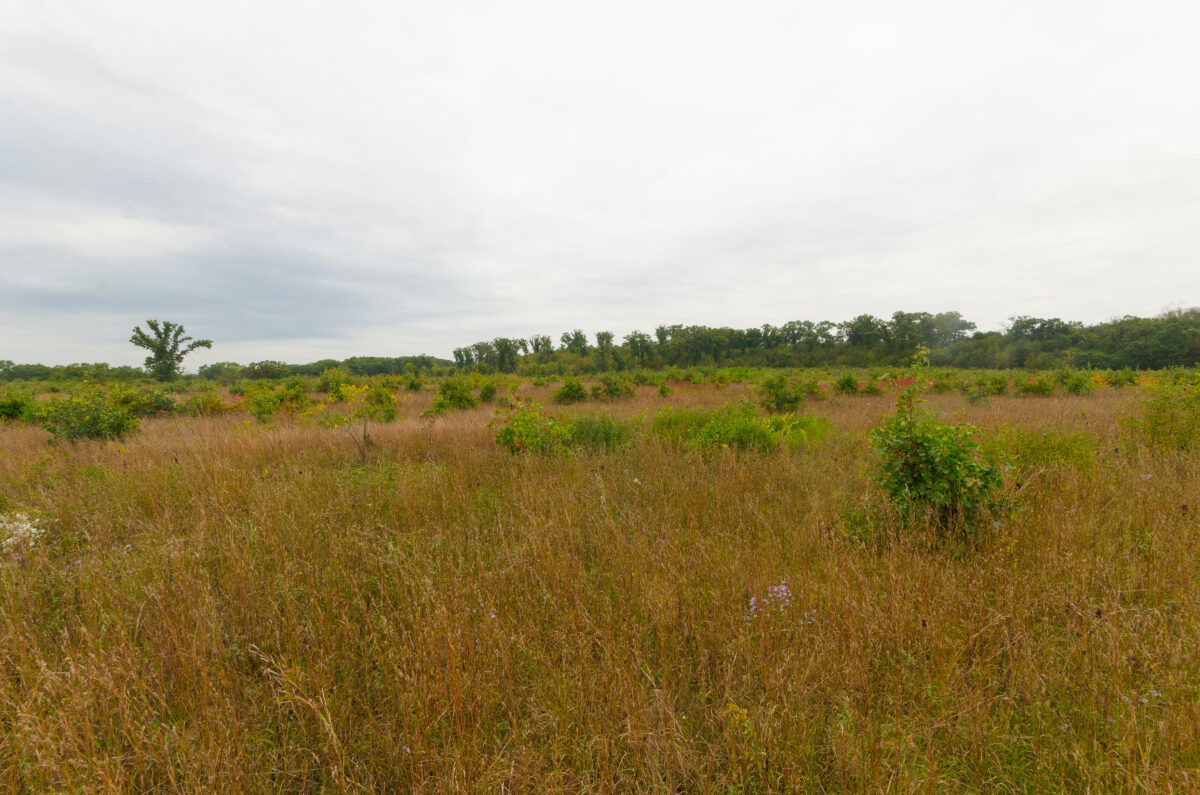Page snapshot: An overview of the world's temperate grassland ecosystems and their common species.
Topics covered on this page: North American prairies; Overview of prairies; Prairie species spotlights; South American grasslands; Overview of the pampas and puna; Pampas and puna species spotlights; Eurasian steppes; Overview of steppes; Steppe species spotlights; South African veldts; Overview of veldts; Veldt species spotlights; Australian temperate savannas; Overview of temperate savannas; Temperate savanna species spotlights; New Zealand tussocks; Overview of tussocks; Tussock species spotlights; Resources.
Credits: Funded by the National Science Foundation. Any opinions, findings, and conclusions or recommendations expressed in this material are those of the author(s) and do not necessarily reflect the views of the National Science Foundation. Page by Naomi Schulberg (2023).
Updates: Page last updated August 3, 2023.
Image above: Prairie in Albany Wildlife Area, Wisconsin, U.S.A. Photo by Joshua Mayer (Wikimedia Commons, Creative Commons Attribution-Share Alike 2.0 Generic license).
Introduction
Temperate grasslands are found at mid-latitudes, and are generally located within continental interiors. They have distinct warm and cold seasons, with temperatures dropping below freezing in the winter. This page will cover temperate grasslands in North America (prairies), South America (pampas and puna), Asia and Europe (steppe), Australia (temperate savannas), and New Zealand (tussocks).
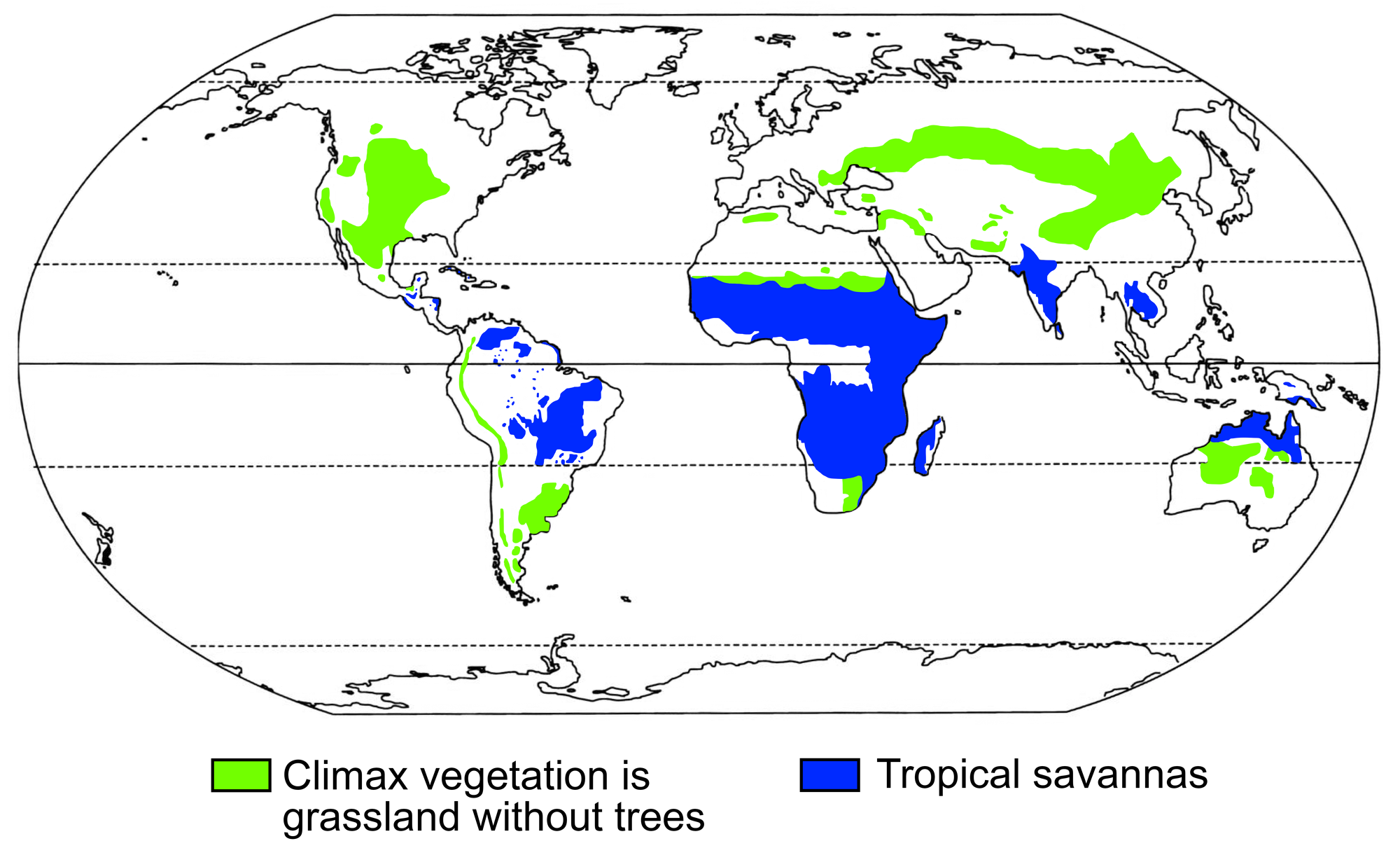
Modern distribution of grasslands (meaning biomes in which the climax vegetation is grass-dominated and lacks tress) and tropical savannas. Modified from figure 1 in Jacobs et al. (1999) Annals of the Missouri Botanical Garden 86: 590-643 (Biodiversity Heritage Library, Creative Commons-NonCommercial-ShareAlike 3.0 Unported license, image cropped, resized, reshaded and relabeled).
North American prairies
Overview of prairies
There are three distinct types of prairies in North America: the Eastern tallgrass prairie, Western shortgrass prairie, and Central mixed-grass prairie. The three prairies support different types of grasses. As the names imply, grasses are taller in the eastern prairies than in the western prairies.
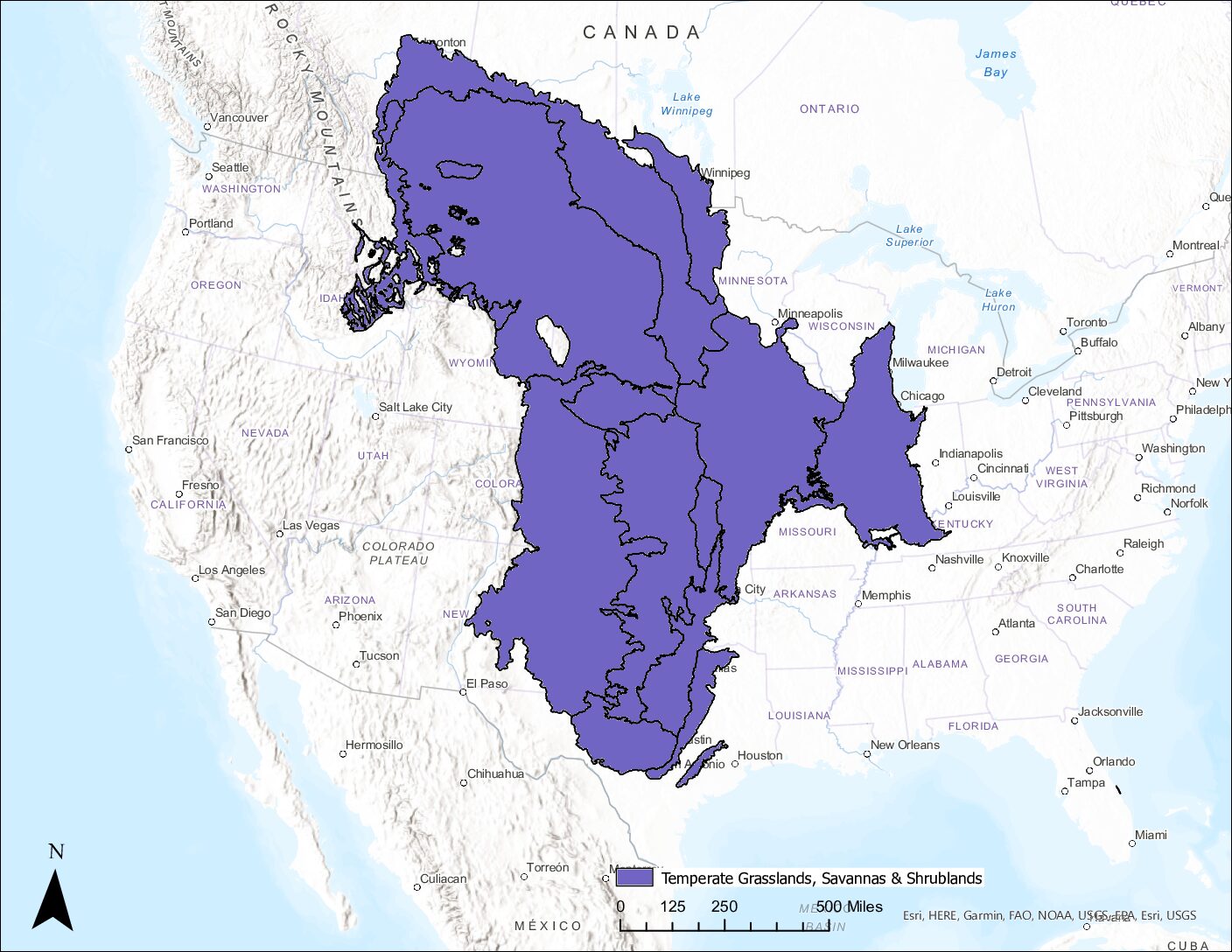
Map of prairies in North America, created by N. Schulberg.
The prairies are distinct from one another due to differences in rainfall. Rainfall ranges from 12 inches (around 30.5 cm) per year in the western shortgrass prairies to 30 inches per year in the eastern tallgrass prairies. The western shortgrass prairie lies in the rain shadow of the Rocky Mountains and so receives very little rainfall. Precipitation increases with increasing distance from the rain shadow; because of this, the central mixed grass and eastern tallgrass prairies are able to support taller and more diverse vegetation.
North American prairies are subject to intense weather and temperature fluctuations, as well as natural hazards such as tornadoes. Grasses are the dominant vegetation in this biome. Both cool-season (C3) grasses and warm-season (C4) grasses grow in the prairies, with C4 grasses dominating this ecosystem.
The prairies also support a variety of animals, including both grazers and predators. Prairie dogs, bison, elk, pronghorn, and deer feed on the grass and prairie plants, and mountain lions, coyotes, and black-footed ferrets in turn feed on the herbivores. Birds, such as the greater sage grouse and the mountain plover, are also supported by the prairie and prey on the herbivorous mammals.
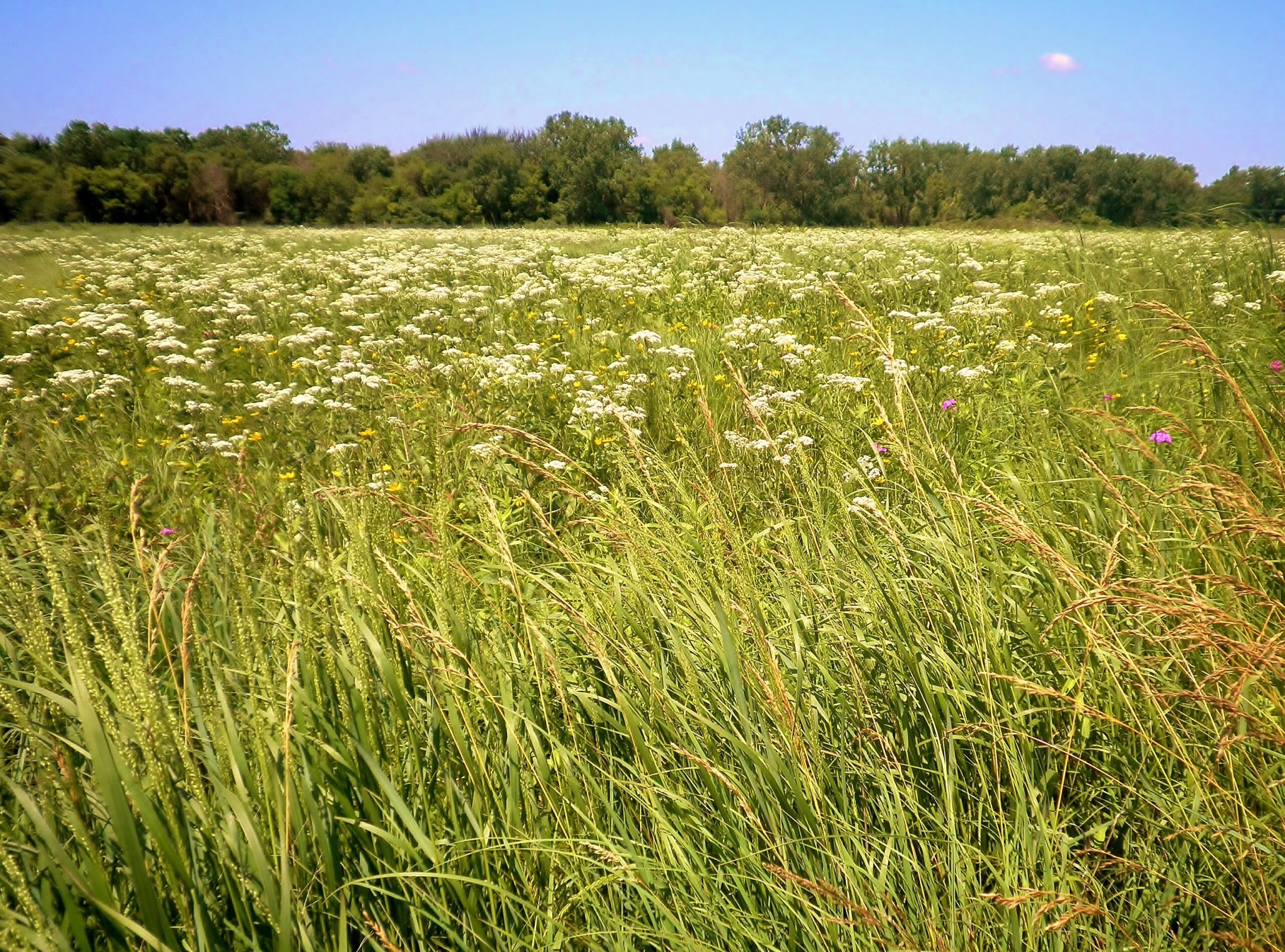
Tallgrass prairie in Gensburg-Markham Prairie, Illinois, U.S.A. Photo by Alan Scott Walker (Wikimedia Commons,Creative Commons CC0 1.0 Universal Public Domain Dedication).
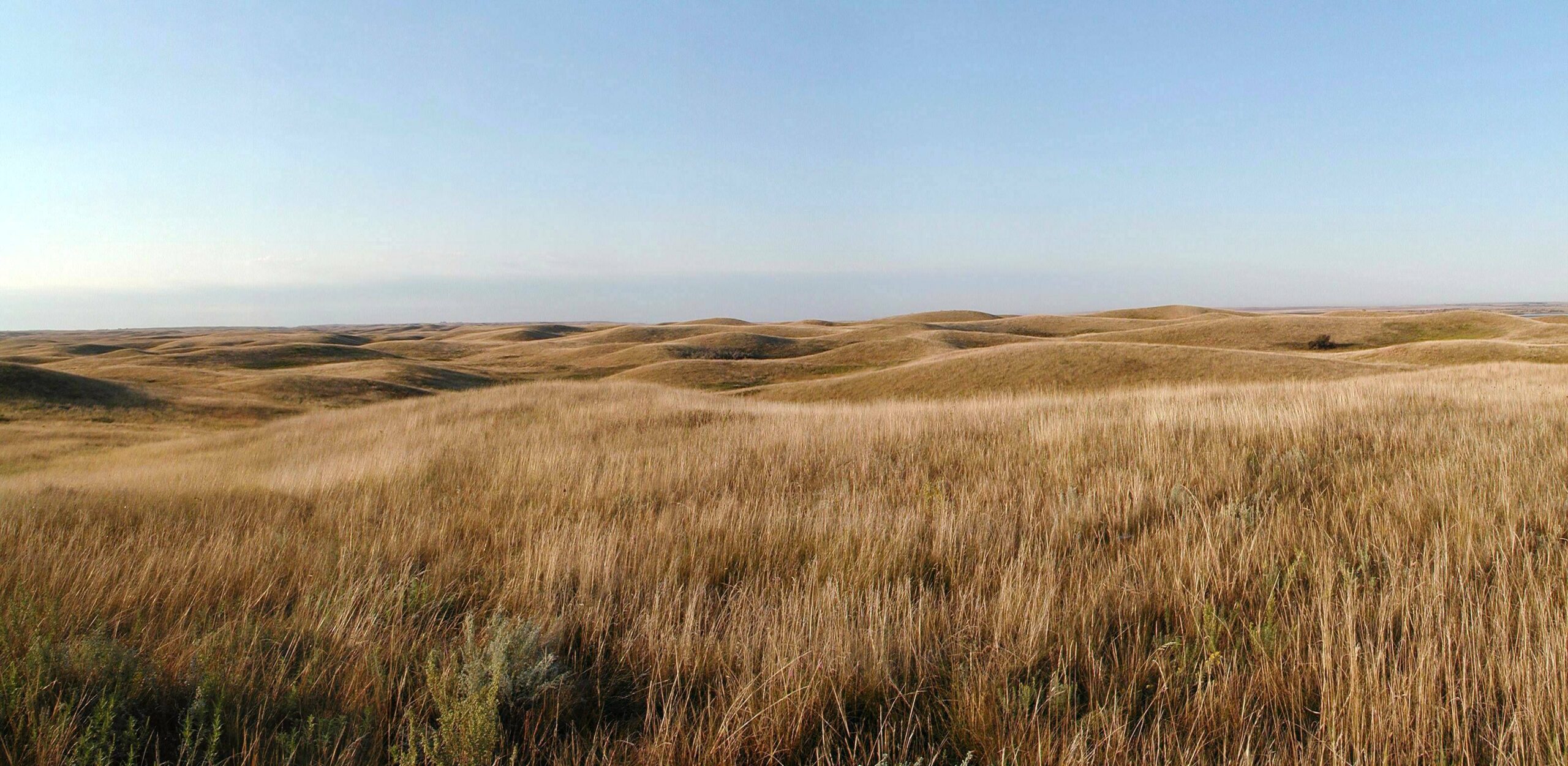
Mixed grass prairie in North Dakota, U.S.A. Photo by the United States Fish and Wildlife Service (Wikimedia Commons, Creative Commons Attribution 2.0 Generic license).
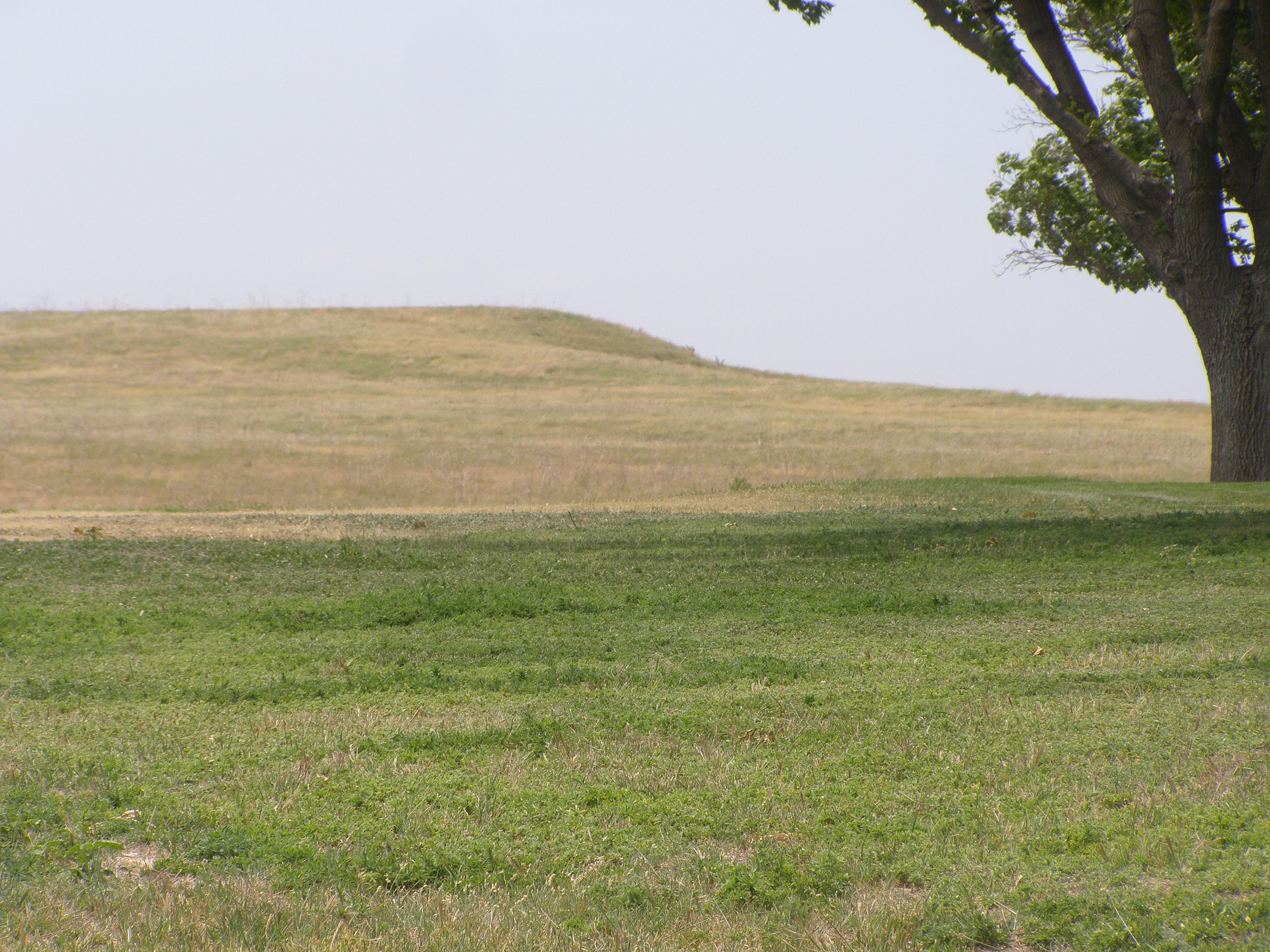
Shortgrass prairie in Nebraska, U.S.A. Photo by Chris Light (Wikimedia Commons, Creative Commons Attribution-Share Alike 4.0 International license).
Prairie species spotlights
Buffalo grass (Bouteloua dactyloides)
Buffalo grass is a perennial C4 grass that is abundant in western shortgrass prairies. It is gray-green in color, with yellow flowers that bloom periodically from April to December. The species is very drought tolerant and spreads prolifically by rhizomes.

Buffalograss (Bouteloua dactyloides). Photo from Josep Gesti (Wikimedia Commons, Creative Commons Attribution-Share Alike 4.0 International license).
Blue grama (Bouteloua gracilis)
Blue grama is a perennial C4 grass that is abundant in western shortgrass prairies. It is the most drought tolerant of all native grasses in North America and is able to survive in areas with only 7 inches (about 18 centimeters) of rain annually. It has yellow flowers, which bloom from July to October.

Blue grama (Bouteloua gracilis). Photo by Karan A. Rawlins, University of Georgia Bugwood.org photo 5427813, Creative Commons Attribution-NonCommercial 3.0 United States License).
Sideoats grama (Bouteloua curtipendula)
Sideoats grama is a perennial C4 grass that is abundant in central mixed-grass prairies. Stems grow to be 2 to 3 feet (about 61 to 91 centimeters) tall at maturity. Flowers are red, orange, and yellow and bloom from June to November.
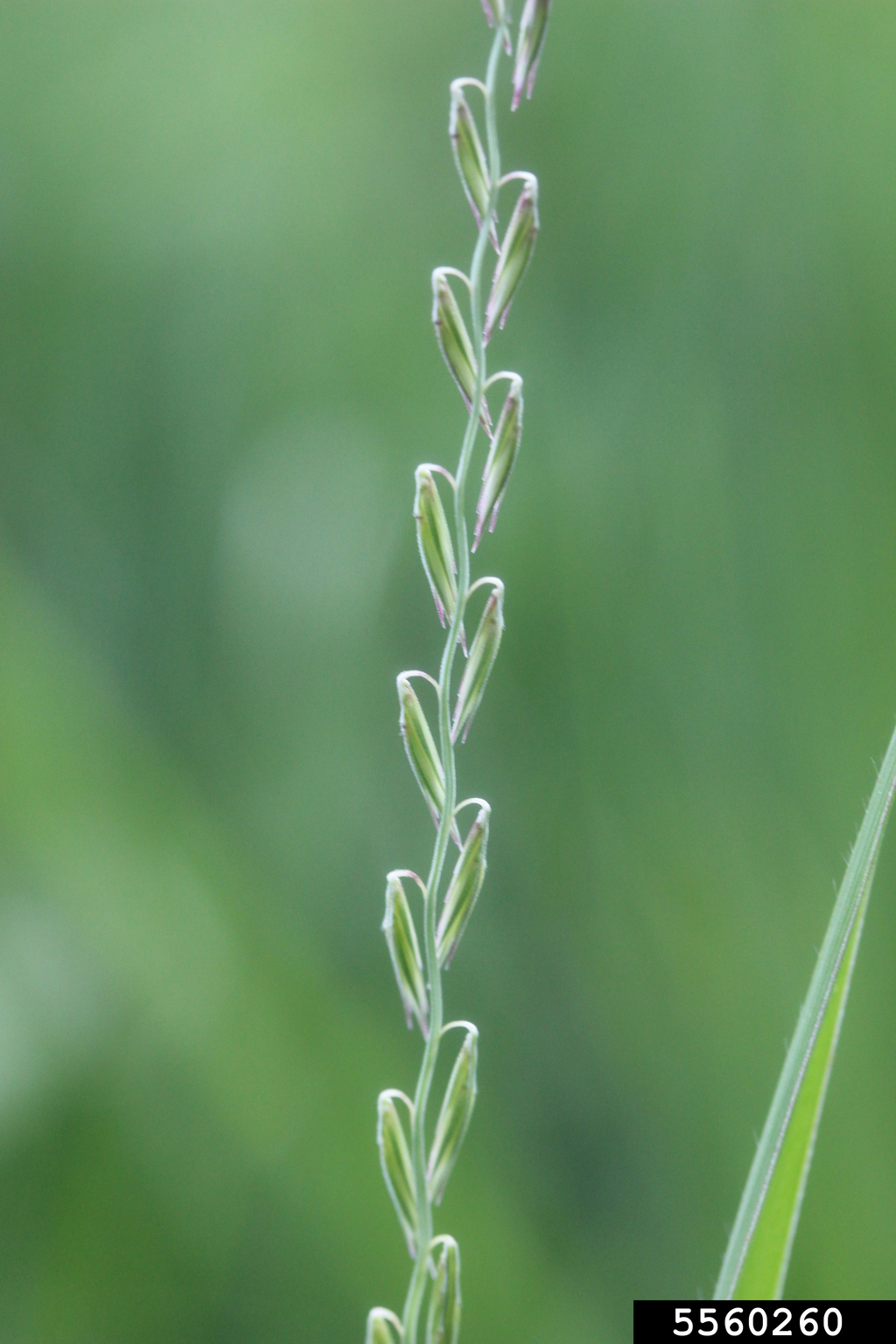
Sideoats grama (Bouteloua curtipendula). Photo by Chris Evans, University of Illinois (Bugwood.org photo 5560260, Creative Commons Attribution-NonCommercial 3.0 United States License).
Big bluestem (Andropogon gerardi)
Big bluestem is a perennial C4 grass that is abundant in eastern tallgrass prairies, with leaves ranging from light yellow to green to burgundy colors. It is found across more than half of the North American continent, with its range extending to the East Coast. It is found in Canada, the United States, Mexico, and Costa Rica. It reaches heights of 6 to 8 feet (about 1.8 to 2.4 meters) when mature. It blooms from August to November, with red, blue, and brown flowers.

Big bluestem (Andropogon gerardi). Photo by Chris Evans, University of Illinois (Bugwood.org 5560202, Creative Commons Attribution-NonCommercial United States 3.0 License).
Yellow indiangrass (Sorghastrum nutans)
Yellow indiangrass is a perennial C4 grass that is abundant in eastern tallgrass prairies. It has blue-green leaves and yellow flowers with red awns that bloom from August to October. Its stems reach up to 8 feet (2.4 meters) tall at maturity. It is especially abundant in areas subject to occasional flooding and is often found in pure stands in lowland areas.
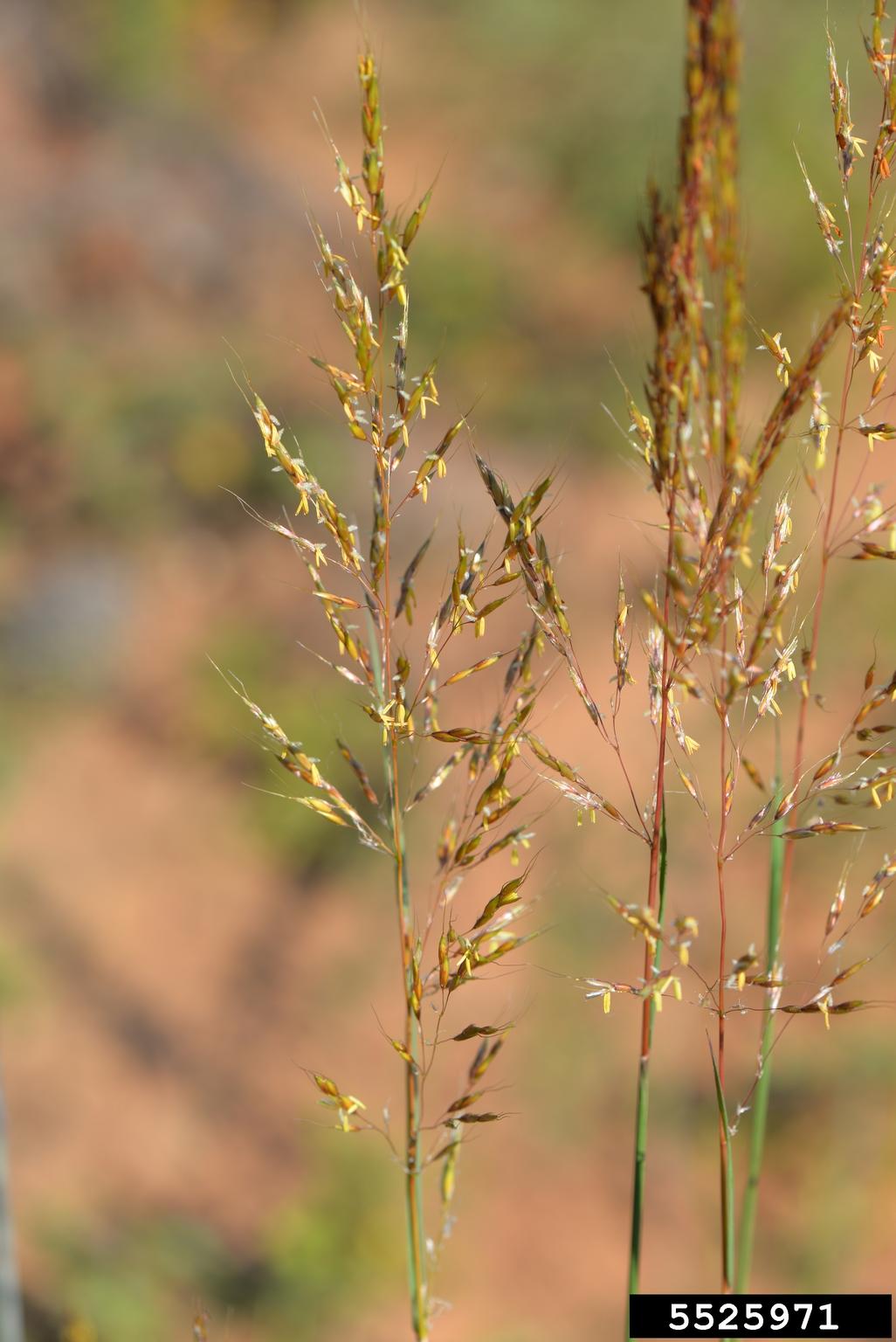
Yellow indiangrass (Sorghastrum nutans). Photo from Karan A. Rawlins, University of Georgia (Bugwood.org photo 5525971, Creative Commons Attribution-NonCommercial 3.0 United States License).
South American grasslands
Overview of the pampas and puna
South American grasslands span from the Atlantic Ocean in the east to the Andes in the West. The climate ranges from subtropical in the north to temperate in the south. Precipitation in the region is lowest in the west due to the rainshadow cast by the Andes, and in some regions there is a dry season in the summer.
The temperate and tropical grasslands of South America are called the pampas. There are three distinct ecoregions within the pampas: the Uruguayan Savanna, Humid Pampas, and Semiarid Pampas. Each of the ecoregions contains a diverse mixture of C3 and C4 annual and perennial grasses. In addition to the pampas, South America also has the puna, which is made up of three regions of montane grasslands in western South America, at high elevations in the Andes mountains.
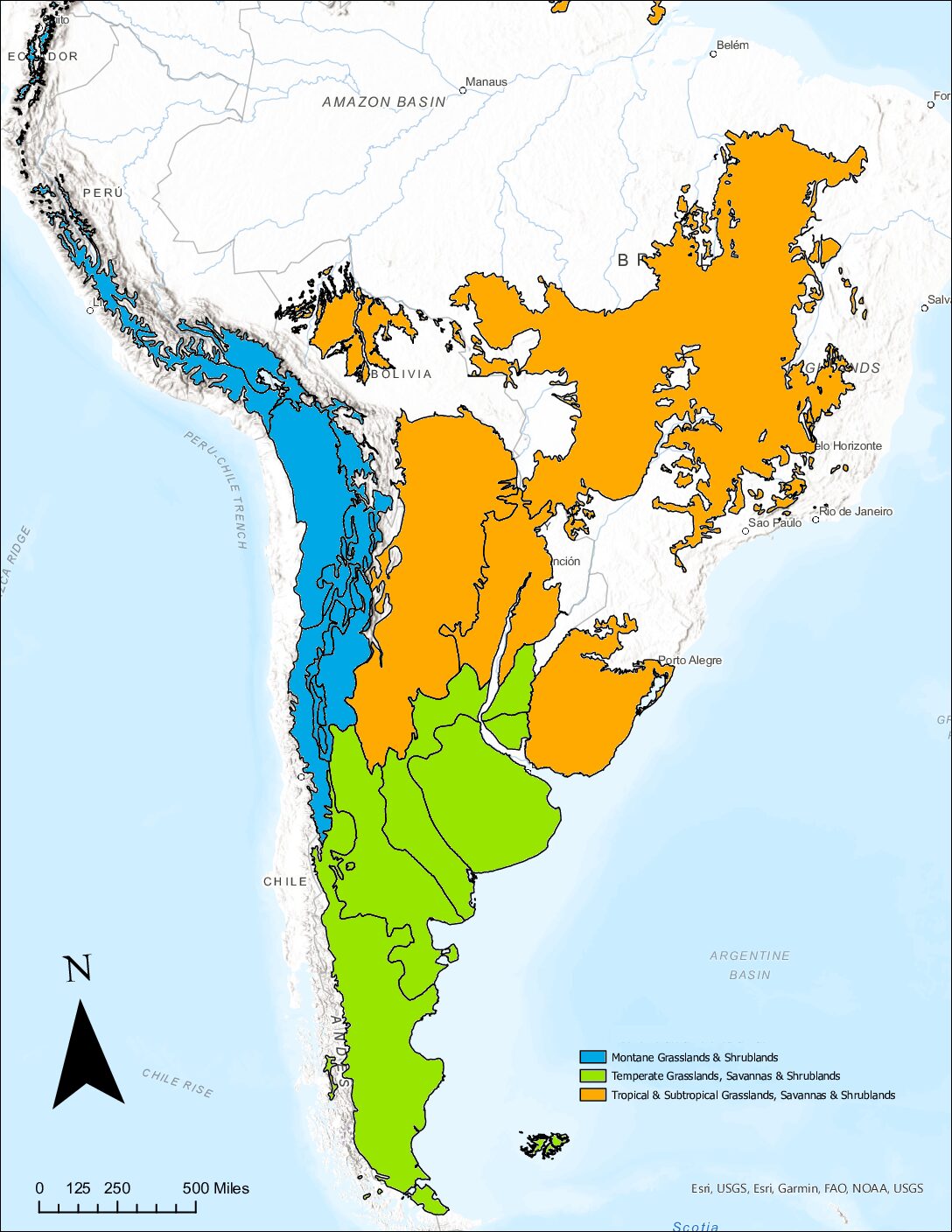
Map of the grassland regions in South America, created by N. Schulberg.
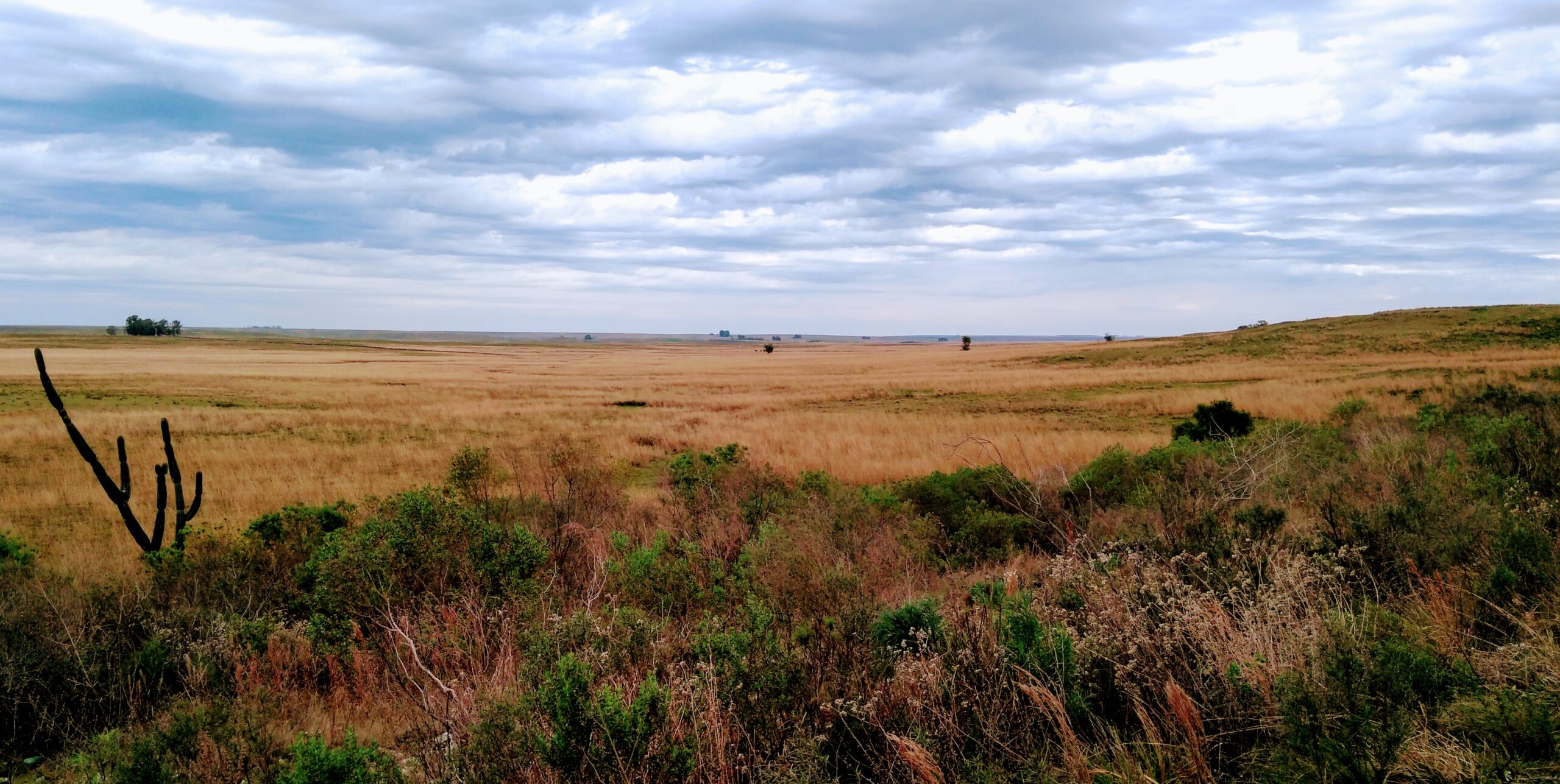
The grass-dominated pampas of southern Brazil. Photo by Carlos Souto (Wikimedia Commons, Creative Commons Attribution-Share Alike 4.0 International license).
Uruguayan savanna
The Uruguayan savanna is a region of subtropical grasslands and savannas. The region primarily supports grasslands, but it also has riparian corridor forests and supports species of palm trees. The climate gets increasingly humid towards the northern part of the region, where average annual rainfall is around 1 meter (more than 3 feet) per year. The grasslands support about 400 species of medium-tall grasses. Two common species, Andropogon lateralis and Dallisgrass (Paspalum dilatatum), are highlighted below.
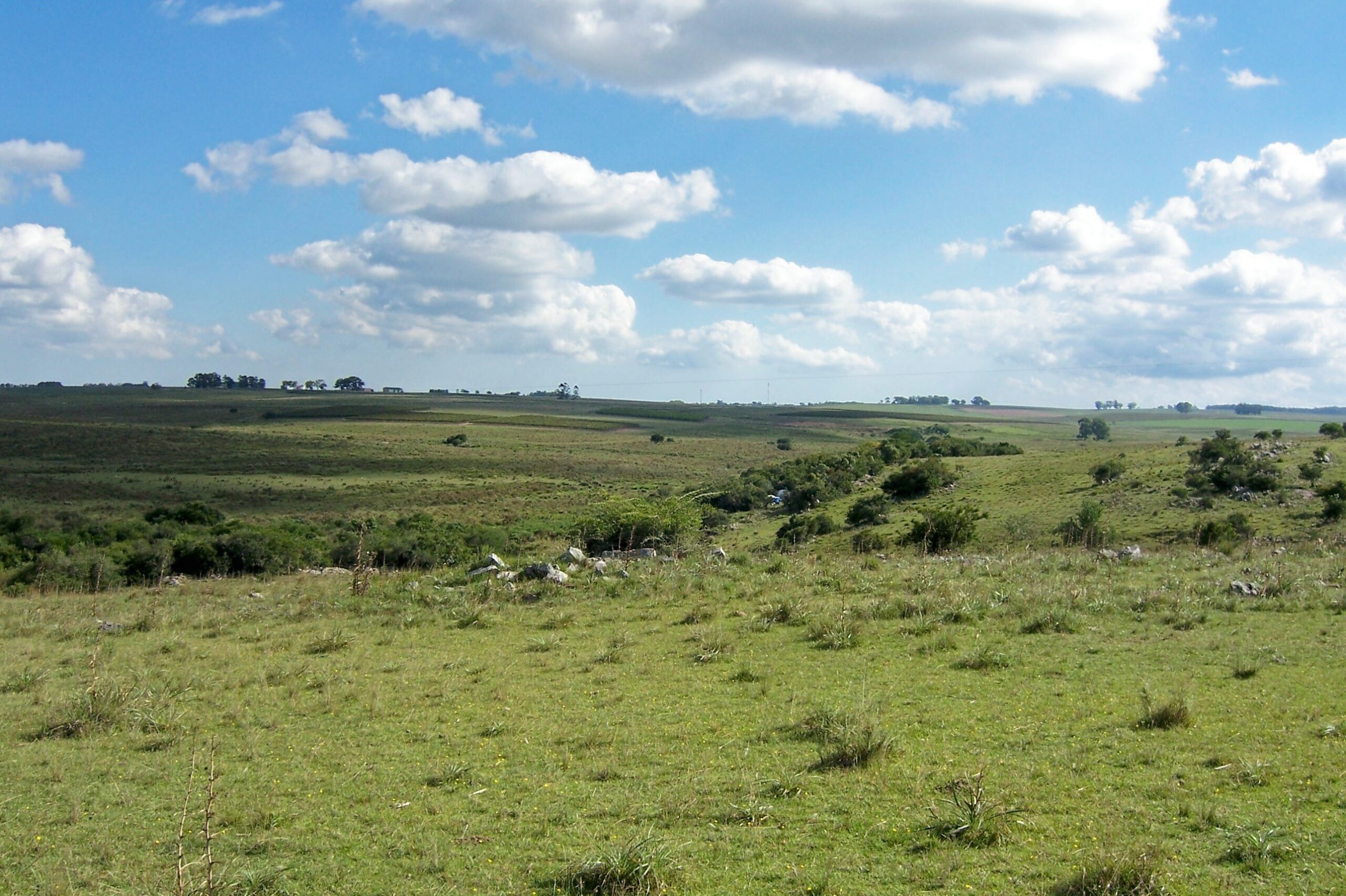
Uruguayan savanna. Photo by Tano4595 (Wikimedia Commons, Creative Commons Attribution-Share Alike 3.0 Unported license).
Humid pampas
The humid pampas is located in Argentina and borders the Atlantic Ocean. It includes the areas around Buenos Aires. With an average annual precipitation of 900 mm (nearly 3 feet), it supports a diverse grassland ecosystem. The grasses are mostly of medium height, and common genera include Nasella, Stipa, and Poa. Much of the region has been developed for agriculture or human settlements, and the ecosystem is considered endangered.
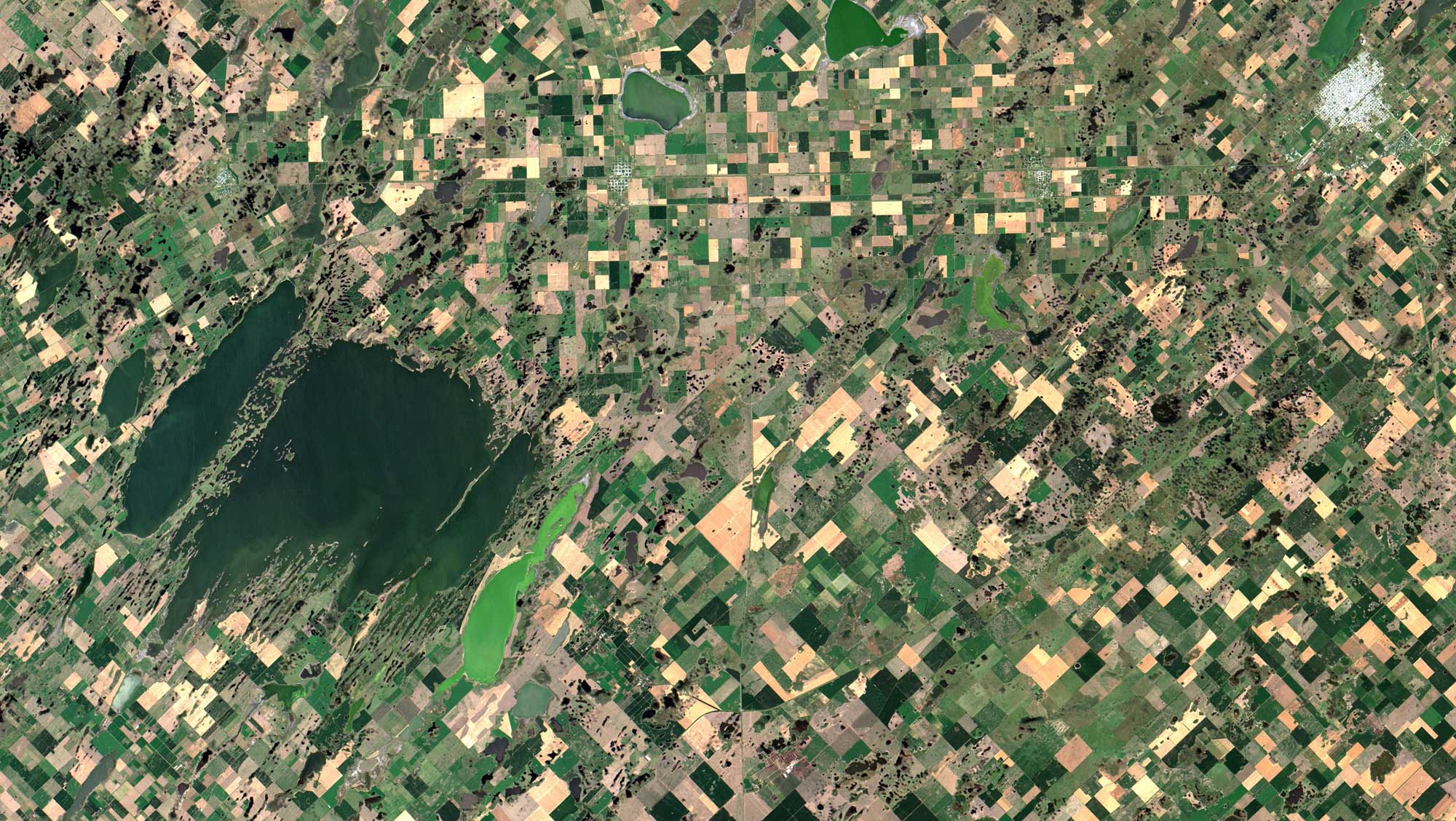
Satellite view of the humid pampas region of Córdoba, Argentina, showing the Las Tunas lake system, 2018. Note that much of the region has been altered by agriculture. Photo by Oton Barros DSR/OBT/INPE (Coordenação-Geral de Observação da Terra/INPE, Creative Commons Attribution-ShareAlike 2.0 Generic license).
Semiarid pampas
The semiarid pampas includes areas of Argentina to the west of the humid pampas. It experiences an average annual precipitation of 700 mm (2.3 feet) per year, about a third less than the humid pampas. Rainfall tends to be unreliable, and the species growing in this area tend to be drought resistant. The semiarid pampas shares similar species to the humid pampas and Uruguayan savanna and also supports some long-grass steppe vegetation.
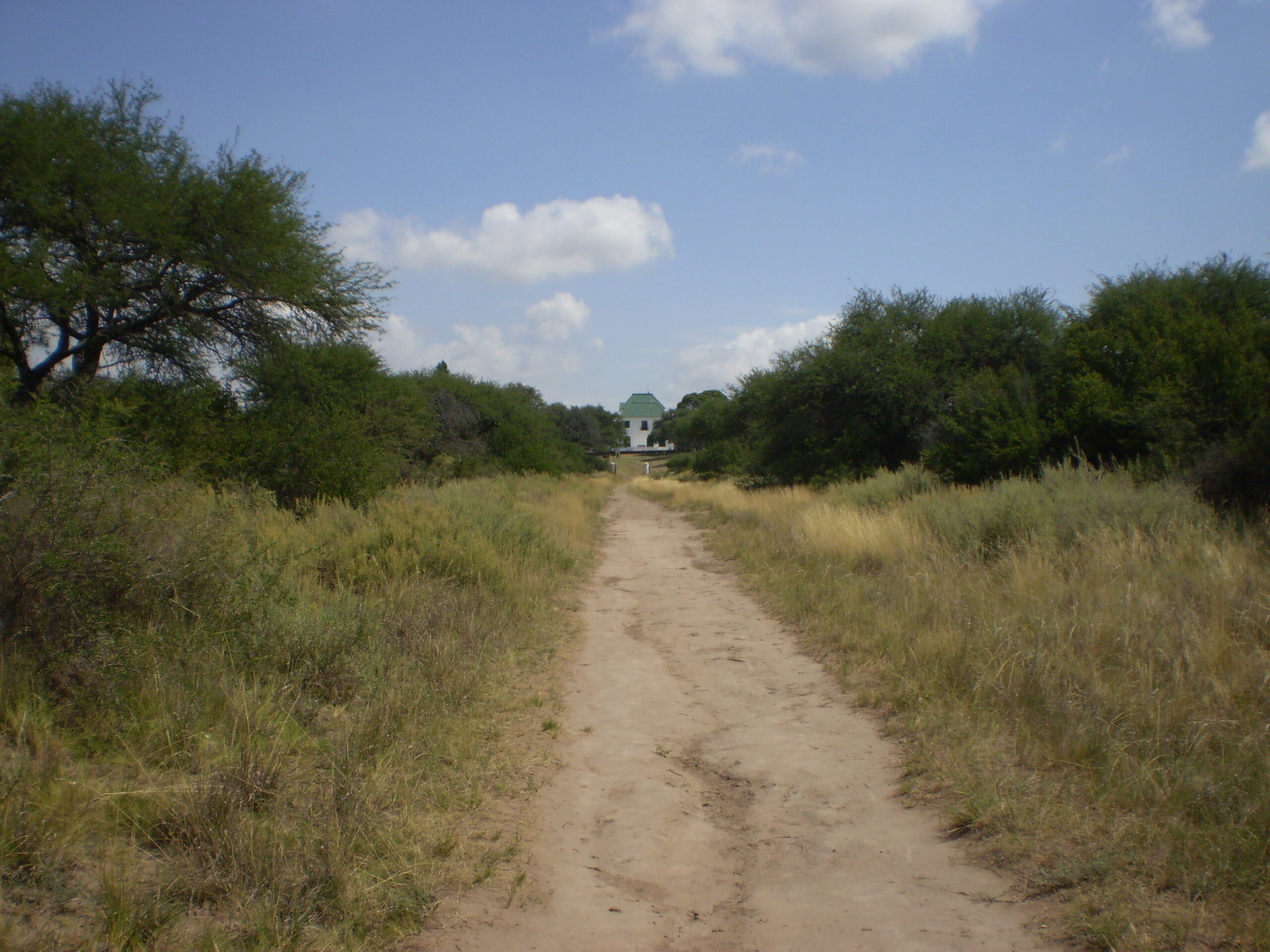
Semiarid pampas, La Pampa, Argentina. Photo by Claudio Elias (Wikimedia Commons, public domain).
Puna
West of the pampas is the puna: a region of montane grassland spanning the Andes mountains in Peru, Bolivia, Chile, and Argentina. It is a high elevation grassland and occupies spaces above the tree line and below the snow line, usually from about 3200 m to 3400 meters (about 10,500 to 11,155 feet) in elevation. Different regions of the puna receive different amounts of precipitation and vary in dryness. The average annual precipitation in the wet puna can be as much as 2000 millimeters (about 79 inches), whereas in the dry puna, which has a dry season that is 8 months long, it can be as low as 400 mm (about 16 inches).
The temperature in the puna ranges from less than 0ºC to 15ºC (32ºF to 59ºF), and the region experiences extreme temperature fluctuations. The dominant vegetation in the puna is similar to the pampas. Common genera of grasses include fescue (Festuca) and reedgrass (Calamagrostis). The region also contains cushion plants, such as species of Azorella.
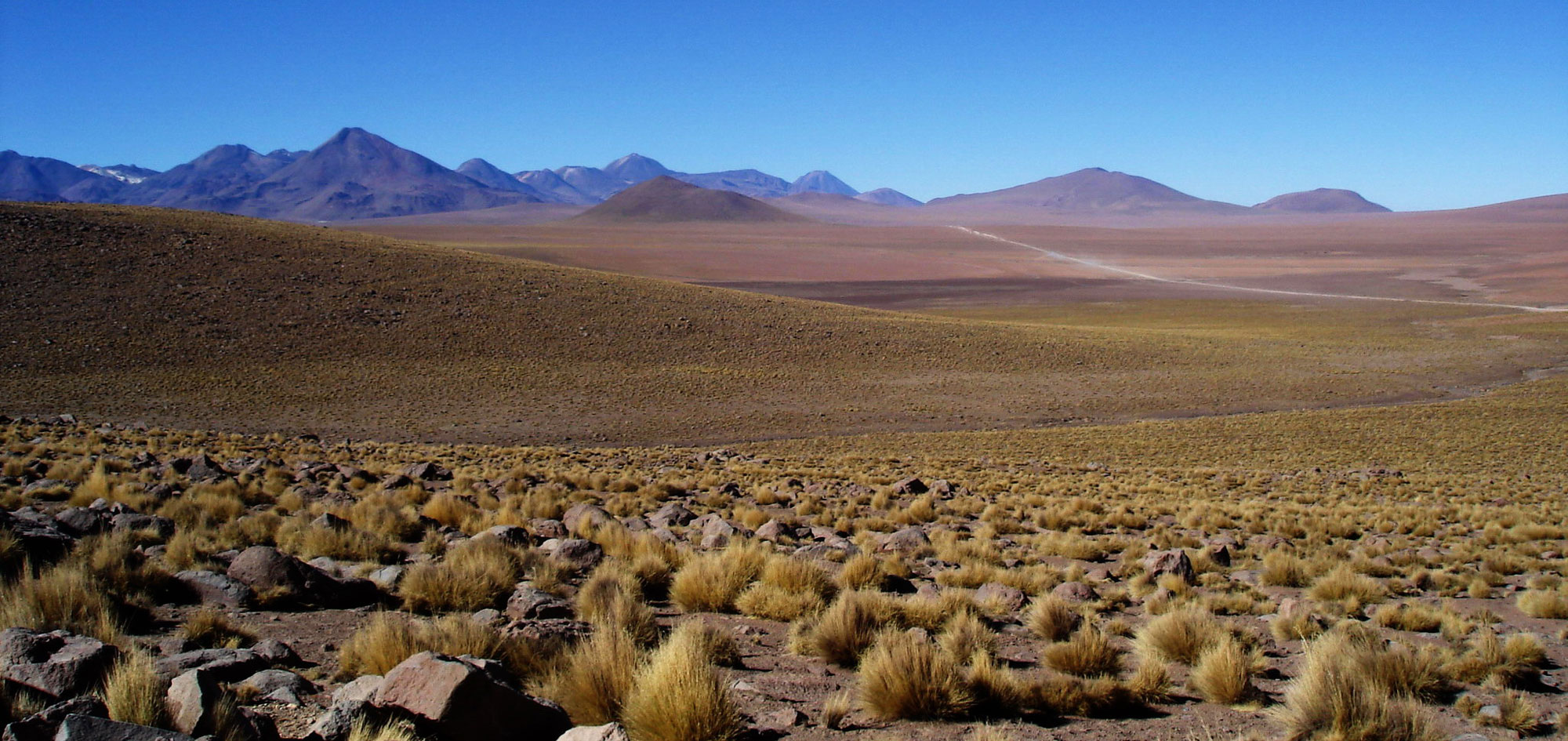
Chilean Altiplano (high plain). Photo by Roman Bonnefoy (Wikimedia Commons, Creative Commons Attribution-ShareAlke 3.0 Unported license, image resized).
Animals of the pampas and the puna
In addition to grasses, the pampas and punas are home to many animals, including birds, such as the great pampas finch, grassland yellow finch, and greater rhea. Mammals include Geoffroy’s cat (a wild cat about the size of a domestic cat), the maned wolf (a canine resembling a fox), and guanacos (animals that resemble llamas).
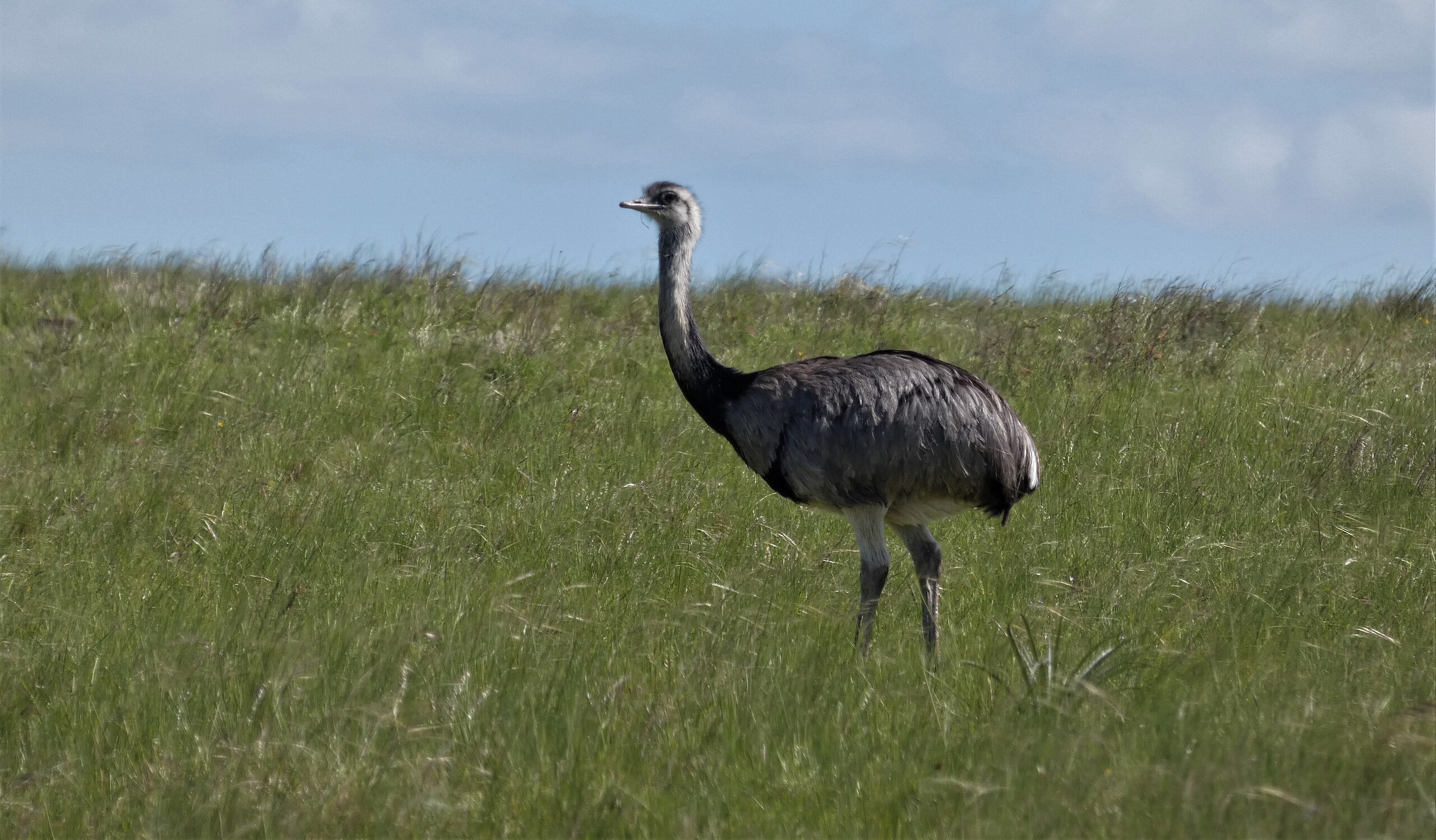
Greater Rhea (Rhea americana) in Uruguay. Photo by Enrique Manuel González González (Wikimedia Commons, Creative Commons Attribution-Share Alike 4.0 International license).
Pampas species spotlights
Pampas grass (Cortaderia selloana)
Native to Brazil, Argentina, and Chile, pampas grass is the most abundant species of grass throughout the pampas region, as well as its namesake. It is a perennial C3 grass and reaches heights of 8 to 12 feet (about 2.4 to 3.7 meters) at maturity. Flowers bloom during the summer, fall, and winter and are a variety of colors.
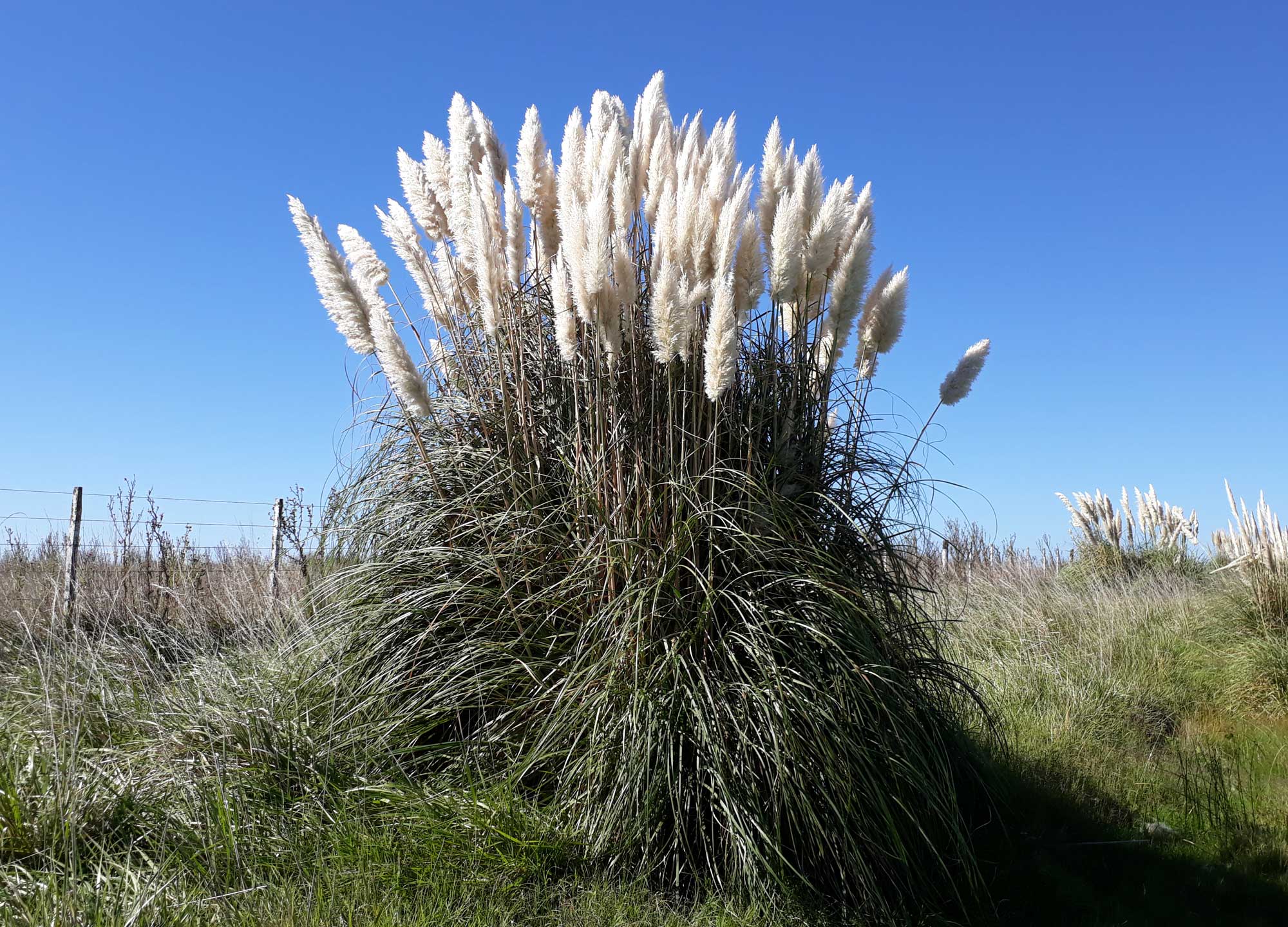
Pampas grass (Cortaderia selloana), Argentina. Photo by Fernando de Gorocica (Wikimedia Commmons, Creative Commons Attribution-ShareAlike 4.0 International license, image cropped and resized).
Andropogon lateralis
Andropogon lateralis is a type of bluestem grass (Andropogon) that is the dominant species in the northern region of the Uruguayan savanna and is well suited to sandy soils. It is a perennial C4 grass with white flowers.
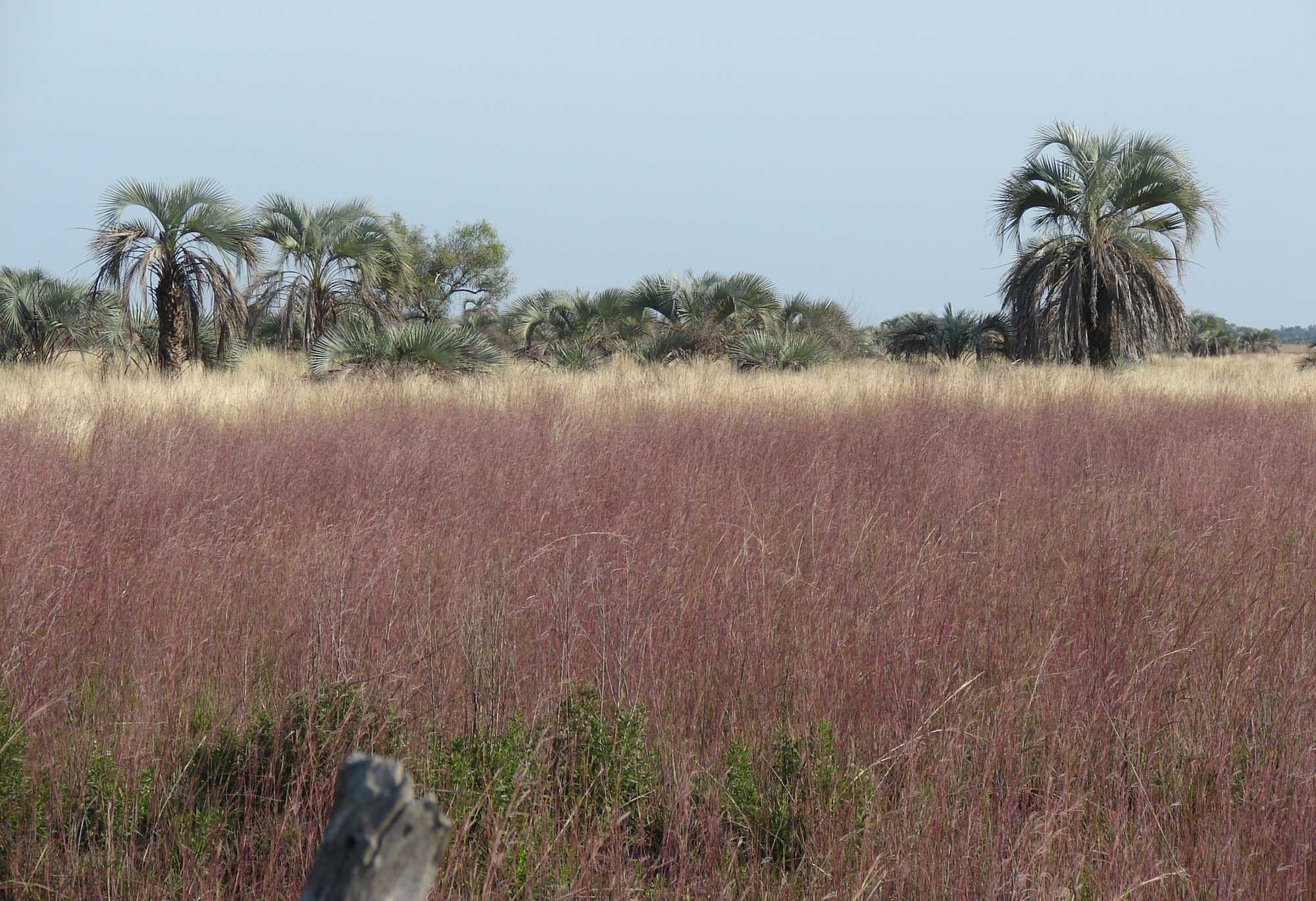
Andropogon lateralis. Photo from Pablo Preliasco (iNaturalist photo 65505030, Creative Commons Attribution-NonCommercial 4.0 International license, image cropped).
Dallisgrass (Paspalum dilatatum)
Dallisgrass is a clumping perennial C4 grass that is abundant in the Uruguayan savanna. It has rolled leaves and distinctive venation. It spreads rapidly through rhizomes and is considered invasive in several areas. It flowers from spring to fall.
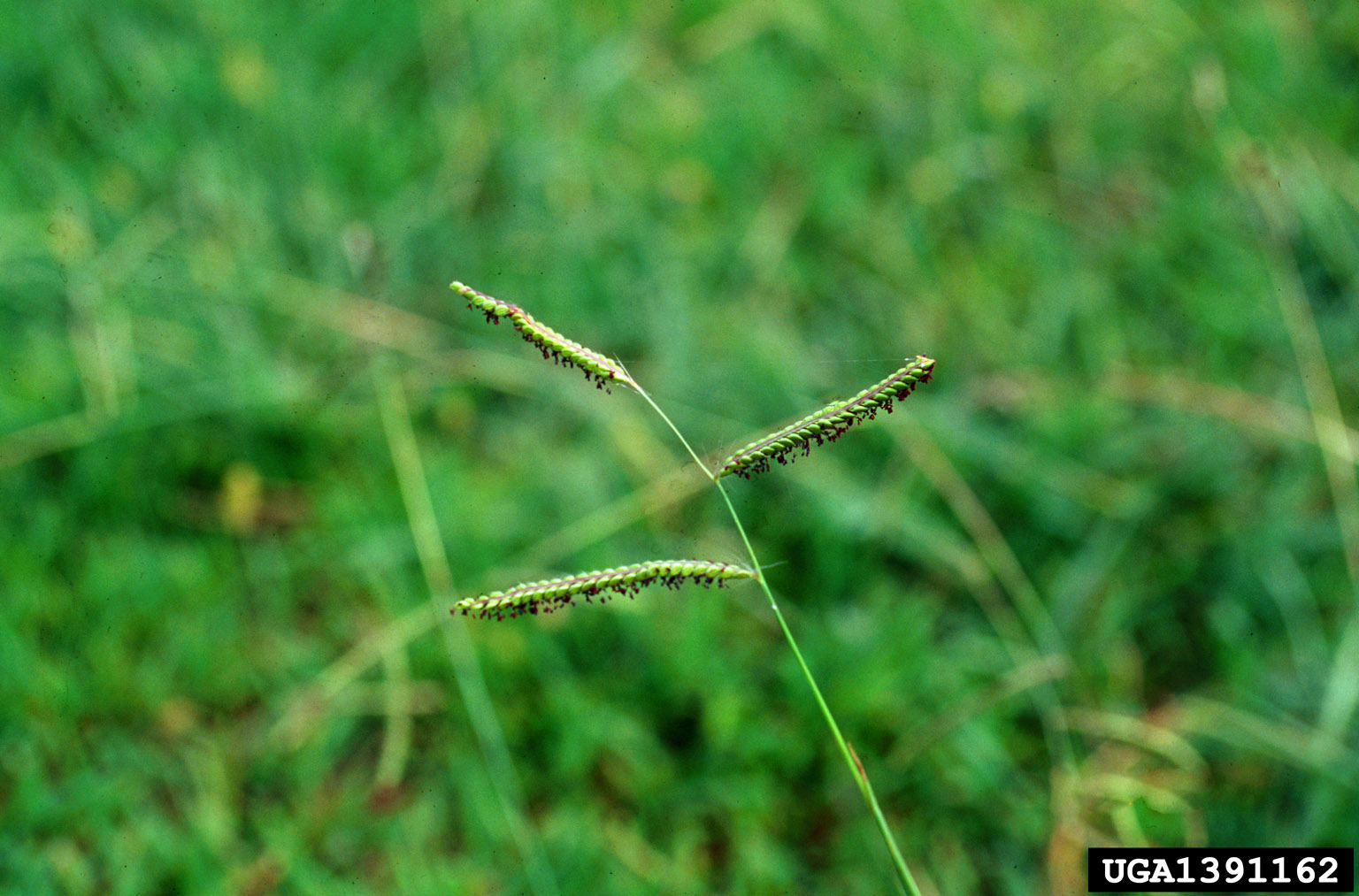
Dallisgrass (Paspalum dilatatum). Photo by John D. Byrd, Mississippi State University (Bugwood.org photo number 1391162, Creative Commons Attribution 3.0 United States License).
Serrated tussock (Nassella trichotoma)
Serrated tussock is a common grass in the humid pampas. It is a perennial C3 species with white flowers that bloom from spring to fall.
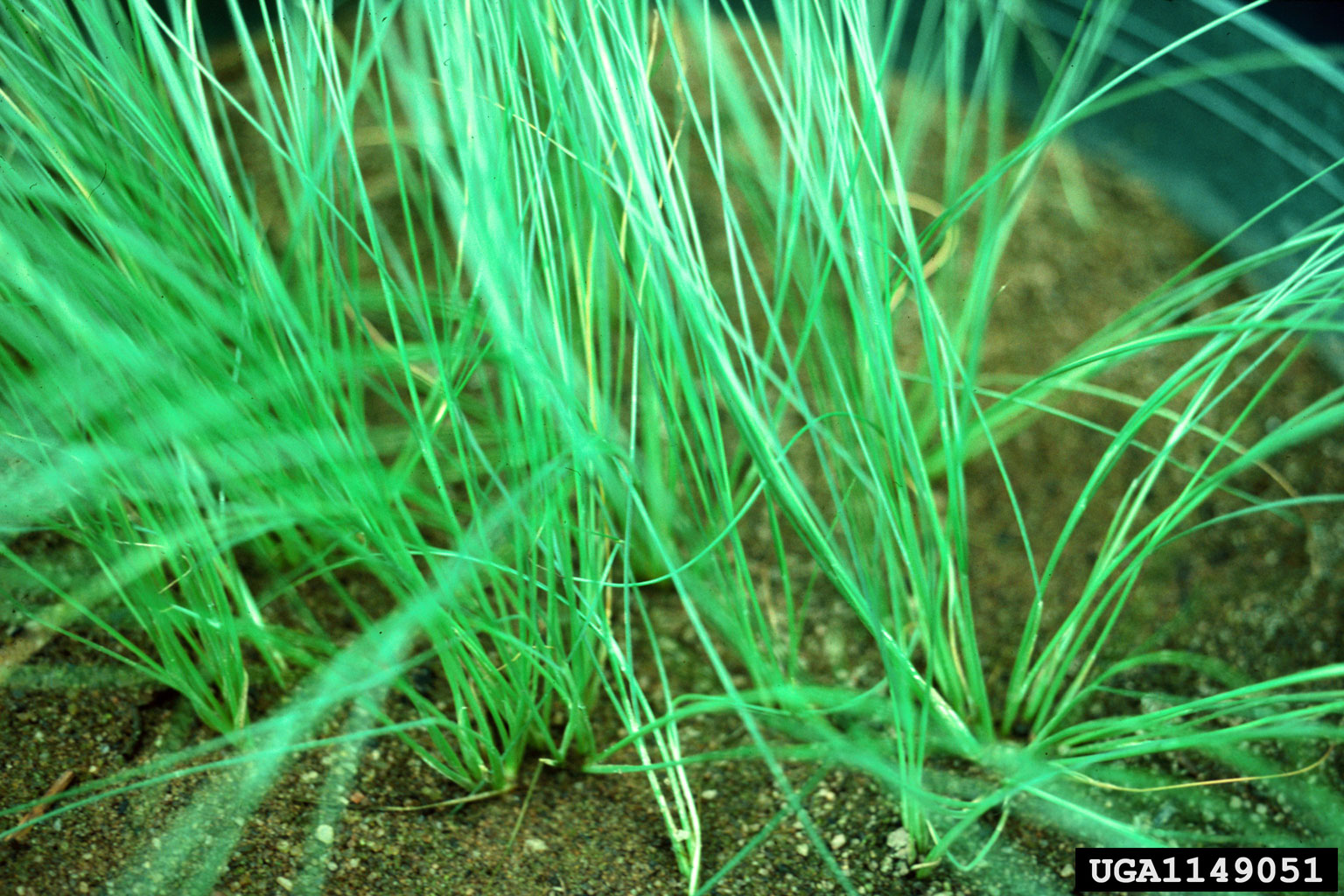
Serrated tussock (Nassella trichotoma). Photo from USDA APHIS PPQ (Bugwood.org photo number 1149051, Creative Commons Attribution 3.0 United States License).
Mexican feathergrass (Nassella tenuissima)
Mexican feathergrass is a perennial C3 grass found commonly in the dry pampas. It grows to be 1 to 2 feet (about 30 to 61 centimeters) tall at maturity and is drought tolerant. It produces silvery yellow to light brown flowers that bloom from summer to fall.
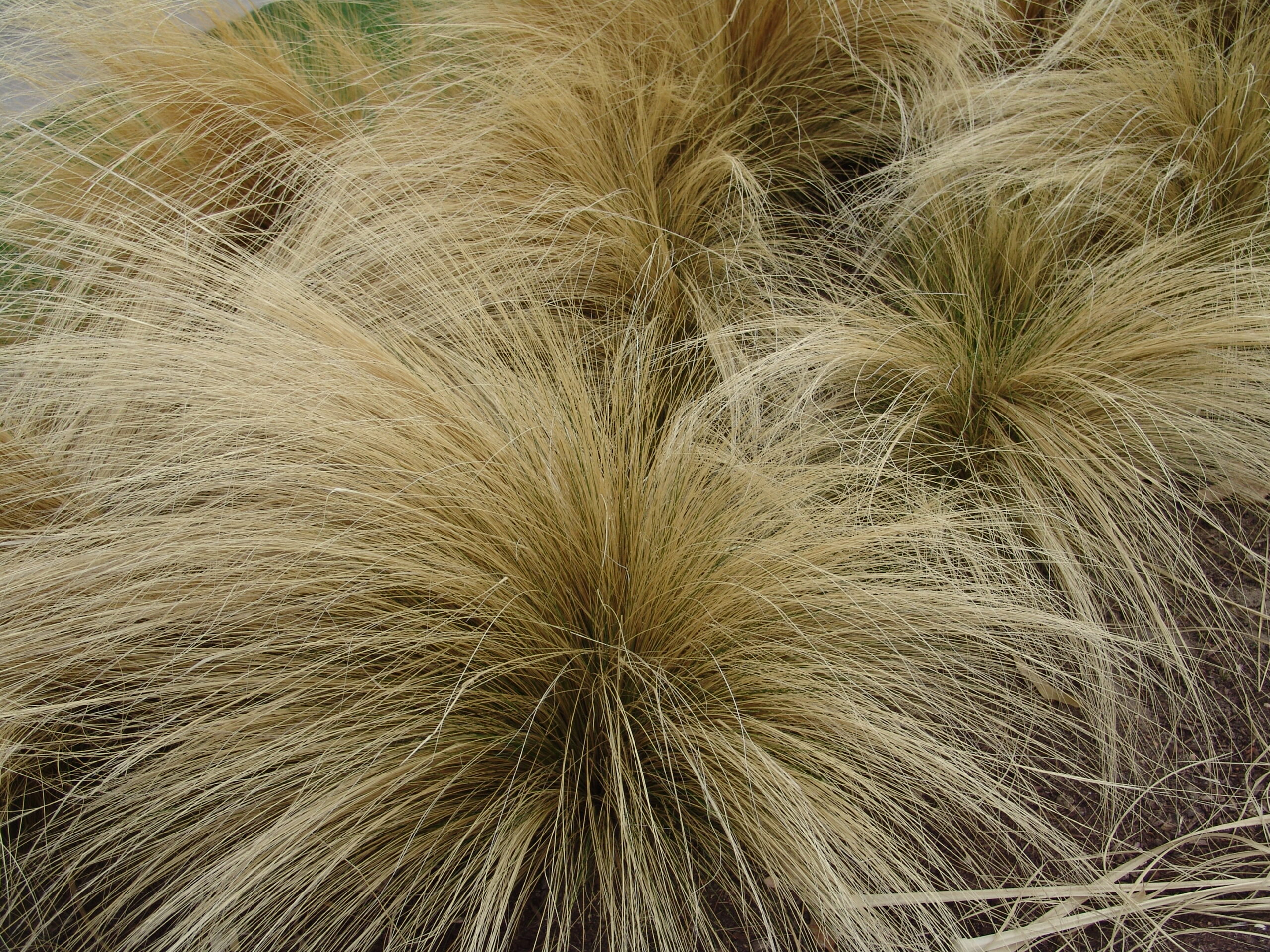
Mexican feathergrass (Nassella tenuissima), cultivated at Denver Botanical Garden, Colorado, USA. Photo by Drew Avery (Wikimedia Commons, Creative Commons Attribution 2.0 Generic license).
Eurasian steppes
Overview of steppes
The Eurasian steppe is the largest temperate grassland in the world. It extends 5,000 miles from Hungary at its westernmost point to China at its easternmost point. The steppe has no clear southern boundary, but the climate becomes increasingly dry towards the south and grades into desert. Towards the north, the climate becomes increasingly humid, and the steppe grades into forest. Overall, the steppe experiences cold, dry winters and warm summers. It is classified as a “semi-arid” region, which receives little rainfall during its relatively short summer.
The steppe has three geographic divisions: the Pontic-Caspian steppe in the west, the Kazakh Steppe in the center, and the Mongolian-Manchurian steppe in the east. The steppe is also divided into over 10 ecoregions based on climate.
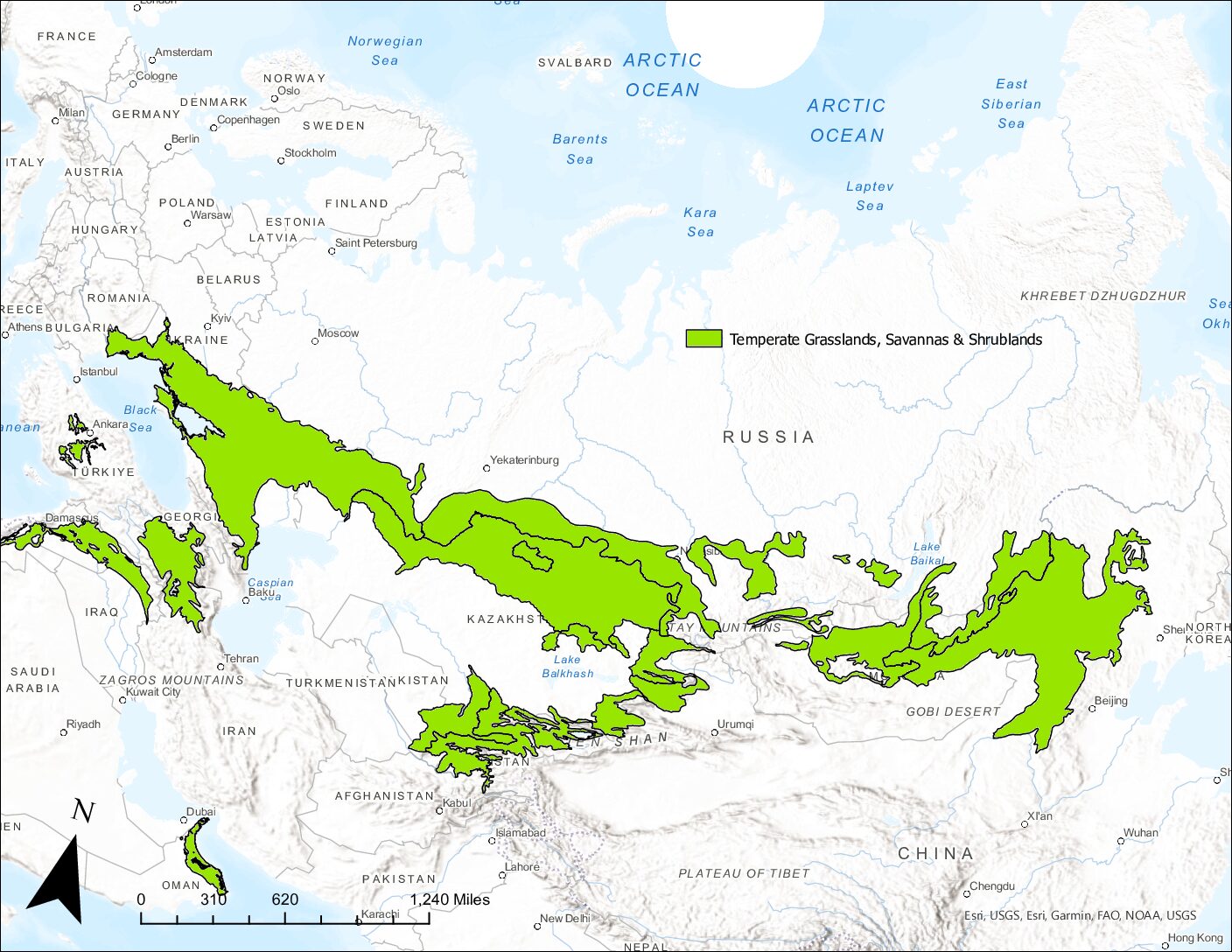
Map of the Eurasian steppe, created by N. Schulberg.
The steppe contains a mixture of C3 and C4 grasses. Common genera include Stipa and Festuca. In addition to grasses, two species of sagebrush or wormwood, Artemisia austriaca and Artemisia nitrosa, are commonly found throughout the steppe. The steppe also supports many animals, such as the antelope saiga (Saiga tatarica) and rodents such as European ground squirrel (Citellus citellus). Bird species including the great bustard (Otis tarda), goitered gazella (Gazella subgutturosa), avocet (Recurvirostra avocetta), and roller (Coracia garrulus).
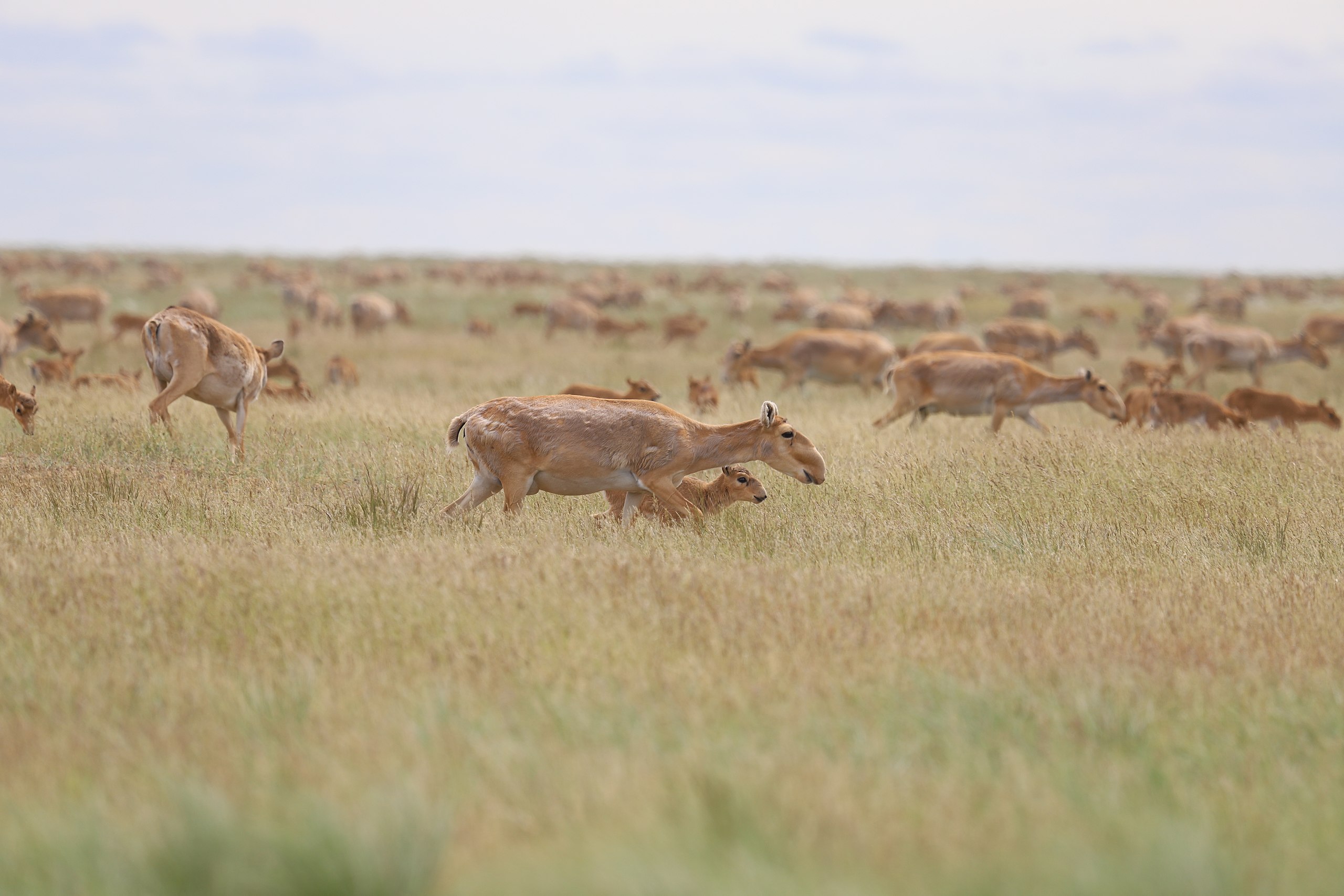
Saigas in the steppe, Kazakhstan. Photo by Aleksandr Putilin (Wikimedia Commons, Creative Commons Attribution-Share Alike 4.0 International license).
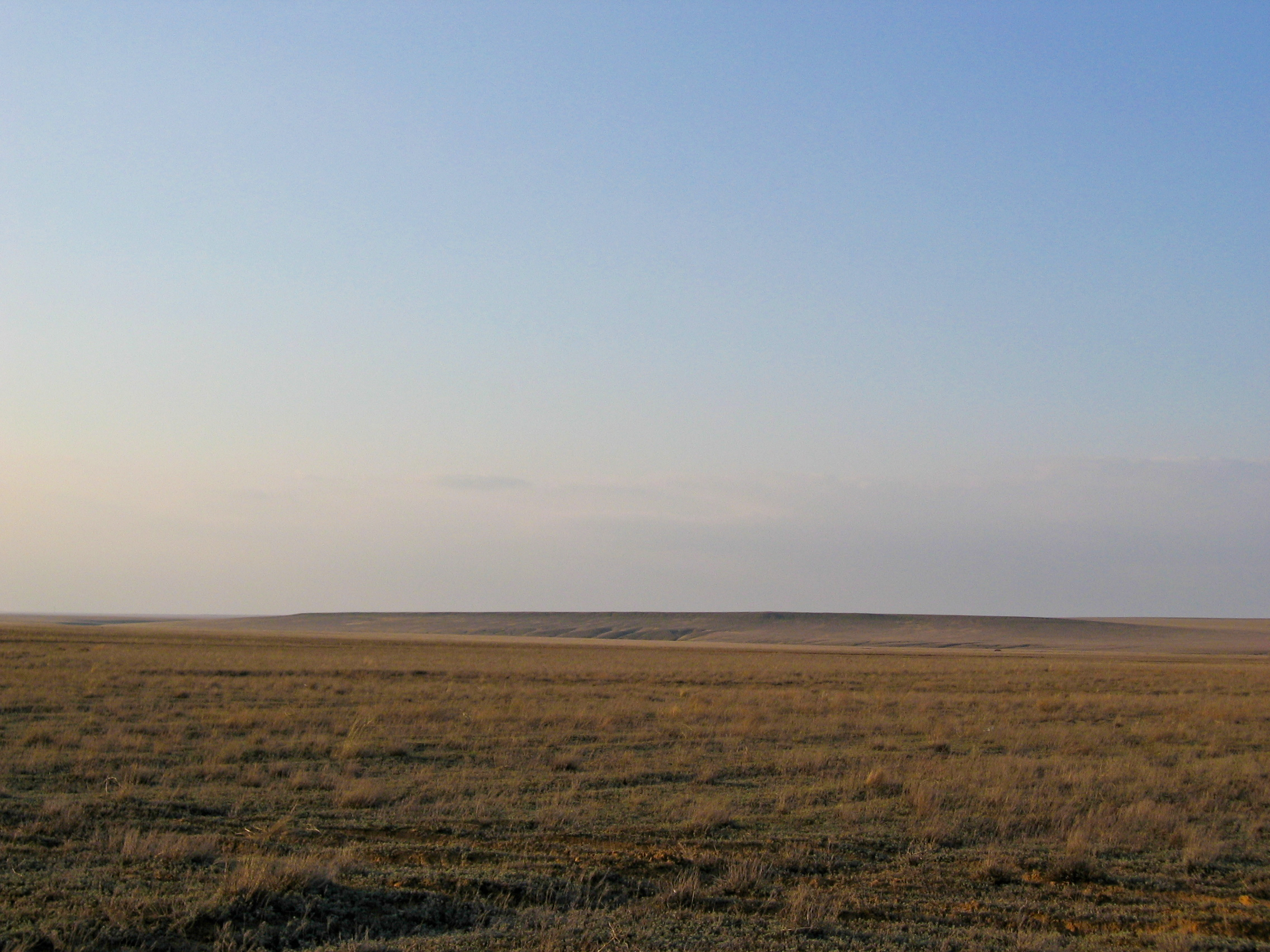
Steppe in western Kazakhstan. Photo by Carol A (Wikimedia Commons, Creative Commons Attribution-Share Alike 3.0 Unported license).
Steppe species spotlights
Needlegrass (Stipa krylovii)
Needlegrass (Stipa krylovii) is a perennial C3 grass species that grows across the Eurasian steppe, ranging from Eastern Europe to Siberia and northern China. It grows to heights of 30 to 50 centimeters (about 12 to 20 inches) and has simple, alternate leaves. Its flowers are arranged in panicles.

Needlegrass (Stipa krylovii), Botanischer Garden, Berlin-Dahlem, Germany. Photo by Krzysztof Ziarnek, Kenraiz (Wikimedia Commons, Creative Commons Attribution-Share Alike 4.0 International license).
Stipa korshinskyi
Stipa korshinskyi is a perennial C3 grass species which grows in the western part of the Eurasian steppe, ranging across Russia and Kazakhstan. It grows to be 35 to 70 centimeters (about 14 to 28 inches) tall. It produces numerous vegetative shoots and has paniculate inflorescences that are up to 22 centimeters (about 8.7 inches) long.

Stipa korshinskyi, Omsk Oblast, Russia. Photo by Andrey Efremov (iNaturalist photo 249186422, Creative Commons Attribution-NonCommercial 4.0 International license).
Lessing feather grass (Stipa lessingiana)
Lessing feather grass (Stipa lessingiana) is a perennial C3 grass species that grows in China, Armenia, and Bulgaria. It grows to be 0.5 to 1 meter (about 20 to 39 inches) at maturity. It is a deciduous grass that flowers from summer to autumn. The flowers are arranged in panicles; they are silver-green in the summer and brown in the fall.

Lessing feather grass (Stipa lessingiana). Photo by Le.Loup.Gris (Wikimedia Commons, Creative Commons Attribution-Share Alike 3.0 Unported license).
South African veldts
Overview of veldts
The Southern African veldt (also called veld) is an area of temperate grassland in large areas of South Africa and part of southern Zimbabwe. It is located in the continental interior, surrounded by the Drakensberg mountains to the south and east and the Kalahari Desert to the north and west. Its climate supports fewer trees than the tropical savannas to its north. Generally, the veldt consists of an area of treeless grassland with some shrubs and scattered bushes.
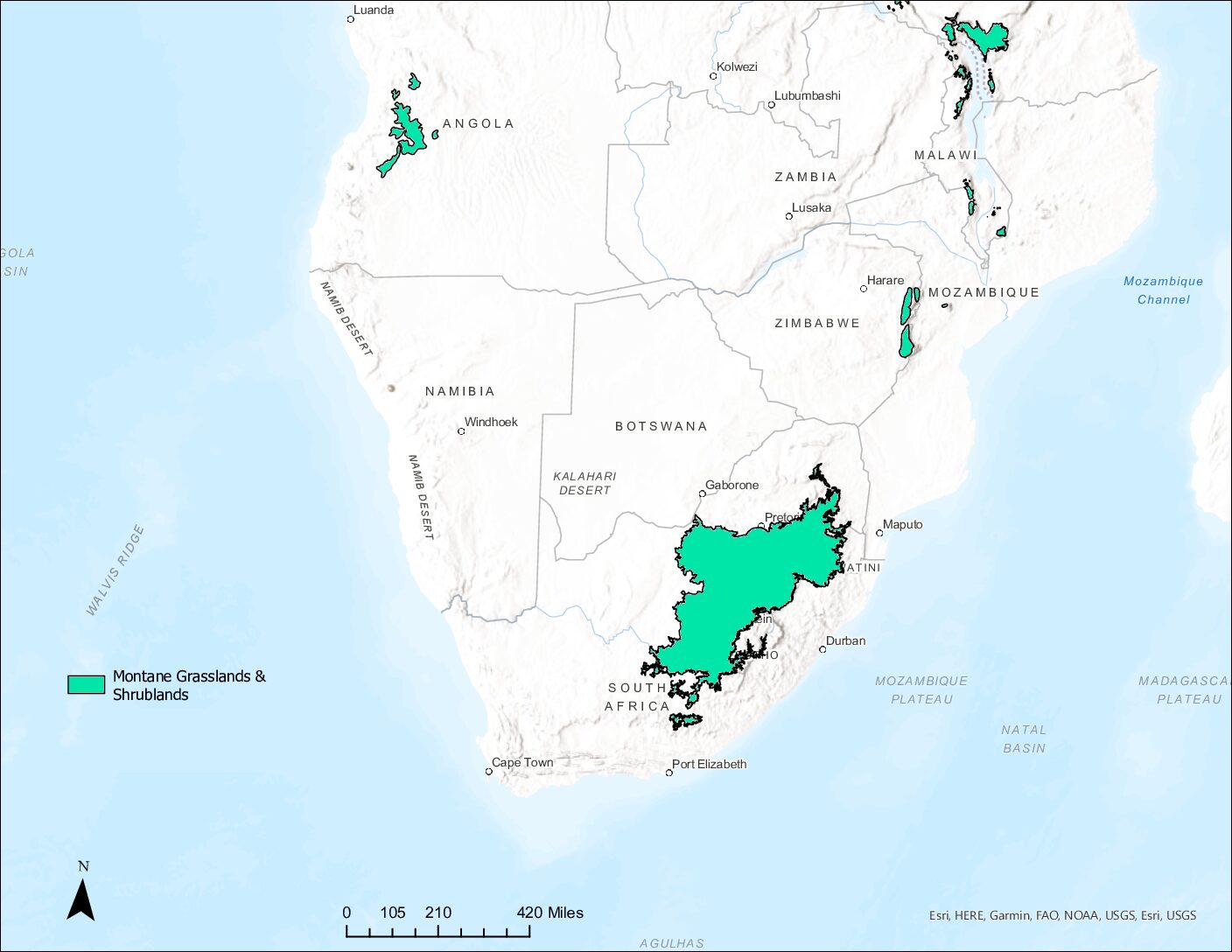
Map of the veldt region, created by N. Schulberg.
Much of the veldt is found in plateaus at relatively high altitude. The climate is characterized by mild winters from May to September and hot summers from November to March. Most of the precipitation falls in the summer during thunderstorms, and frequency and intensity of rainfall is variable. Average annual precipitation ranges from 40 to 120 centimeters (about 15.75 to 47 inches), decreasing from east to western areas of the region. Some areas receive snow in the winter.
The veldt varies in climate, flora, and fauna. Officially, 67 different grassland units within the veldt have been described, which have been grouped into 6 regions: 1) the central inland plateau, 2) the dry western region, 3) the northern Areas, 4) the eastern inland plateau, 5) the eastern mountains and escarpment, and 6) the eastern lowlands. Colloquially, regions of the veldt are referred to as “sweet veldts” and “sour veldts,” named according to their palatability to livestock. Sweet veldts are found in regions of the Eastern Cape that are semi-arid with high-nutrient soils, while sour veldts are found in regions with high rainfall and acidic soils.
Overall, the vegetation is strongly dominated by hemicryptophytes (perennial plants with buds close to the soil surface) in the Grass Family (Poaceae). Dominant taxa vary by region, but, overall, the flora and fauna of the veldt overlap with those of the African savanna. For example, one of the most common species in the veldt, red oat grass (Themeda triandra), is also abundant in the savanna.
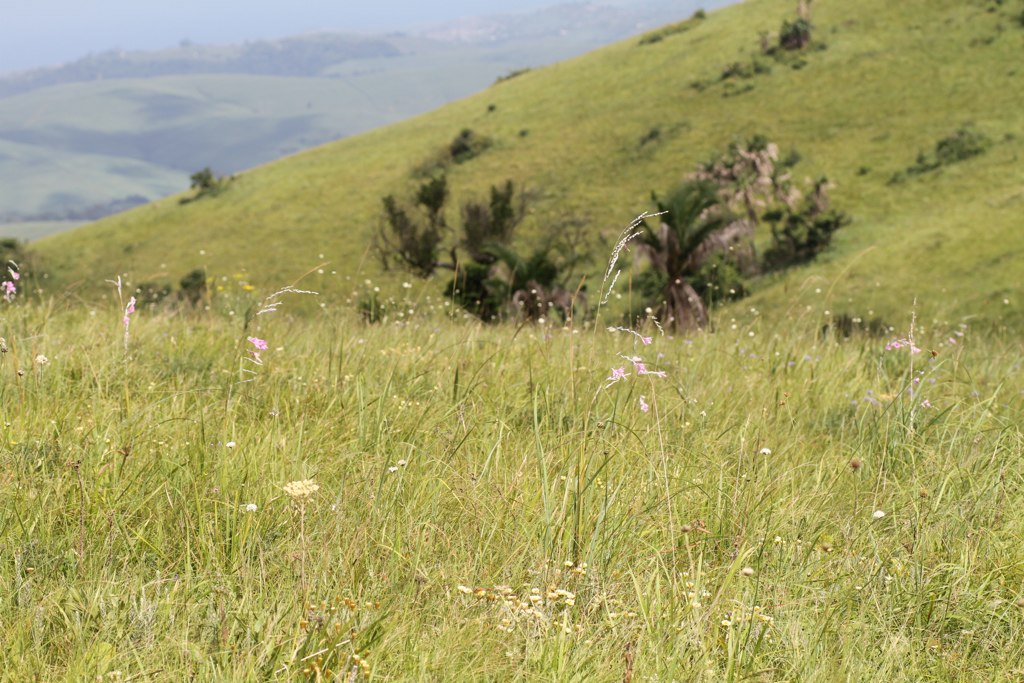
Veldt, Vernon Crookes Nature Reserve, South Africa. Photo by Alexey Yakovlev (Wikimedia Commons, Creative Commons Attribution-Share Alike 2.0 Generic license).
Veldt species spotlights
Weeping lovegrass (Eragrostis curvula)
Weeping lovegrass is a perennial C4 plant found in the central inland plateau region of the veldt. This region receives between 60 and 70 centimeters (about 24 to 28 inches) of precipitation each year. Purple lovegrass grows to a height of about 30.5 to 61 inches (1 to 2 feet) tall at maturity and flowers from July to September. Its flowers are purple-red.

Weeping lovegrass (Eragrostis curvula), South Africa. Photo by Dave Richardson (iNaturalist photo 152721888, Creative Commons Attribution 4.0 International license).
Lehmann lovegrass (Eragrostis lehmanniana)
Lehmann lovegrass is a perennial C4 plant found in the dry western region of the veldt, which is located at altitudes of between 1,200 and 1,400 meters (about 3940 to 4590 feet) and receives 45 to 60 centimeters (about 18 to 23.6 inches) of precipitation each year. The plant grows to be 1.5 to 2 feet (about 46 to 61 centimeters) at maturity and produces many seeds.
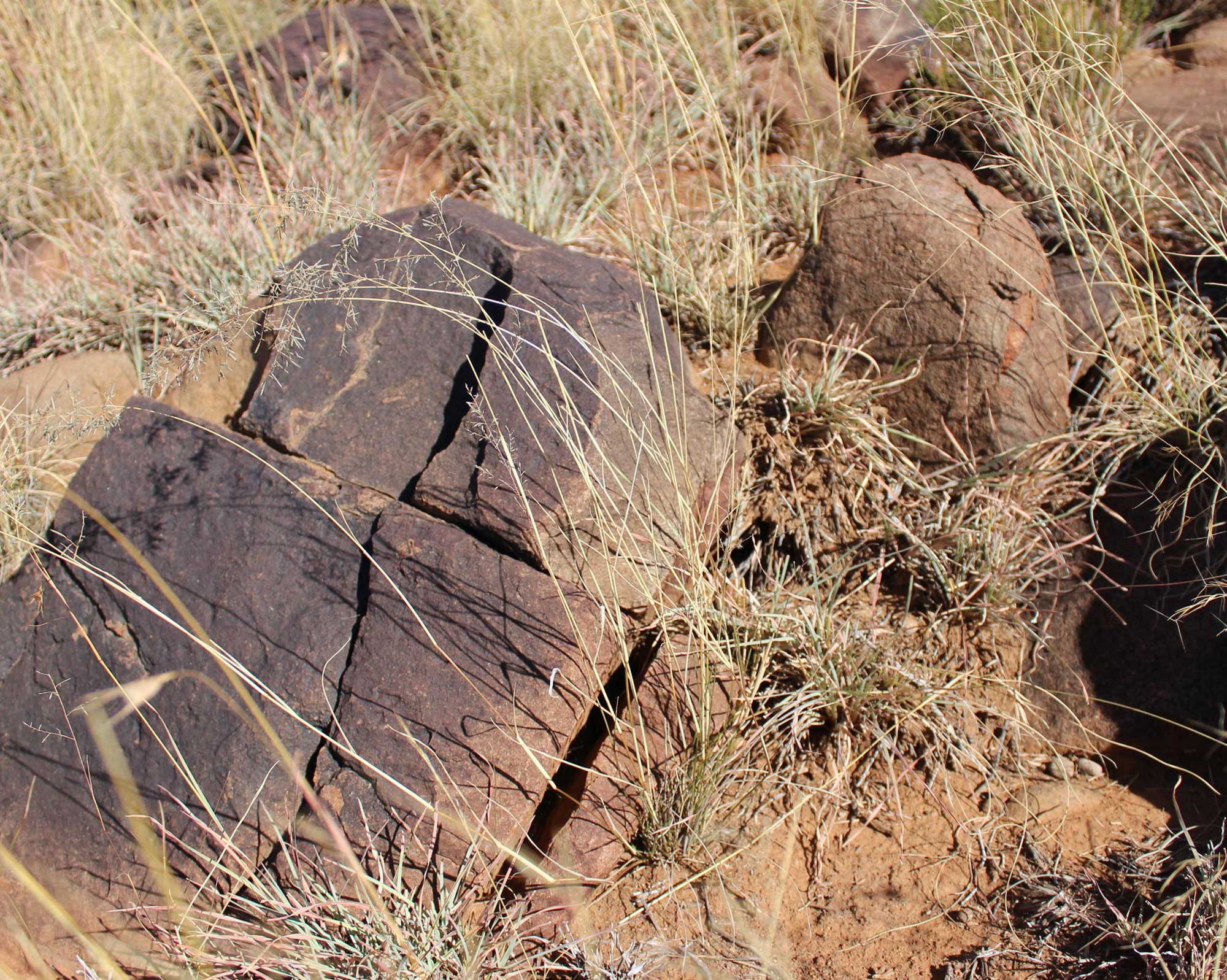
Lehmann Lovegrass (Eragrostis lehmanniana). Photo from Luke Gallant (iNaturalist photo 15952763, Creative Commons Attribution-NonCommercial 4.0 International license).
Small bushman grass (Stipagrostis obtusa)
The small bushman grass is a perennial C4 plant found in the dry western region of the veldt. It is a common species across both tropical savannas and the veldt in Africa, covering areas of Botswana, Namibia, and South Africa. It is most frequently found on sandy soils. It grows in tufts and produces green flowers.

Small bushman grass (Stipagrostis obtusa) in Namibia. Photo from Jon Richfield (Wikimedia Commons, Creative Commons Attribution-Share Alike 3.0 Unported license).
Common thatching grass (Hyparrhenia hirta)
Common thatching grass is a perennial C4 plant commonly found in the eastern mountains and escarpment region of the veldt, which occurs at high altitudes (1,650 to 3,500 meters or about 5400 to 11,480 feet) and receives over 1000 mm (more than 3.2 feet) of precipitation annually. It produces many seeds and is invasive in many parts of the world. It grows in clumps and stems are up to 1 meter (about 3.2 feet) tall.
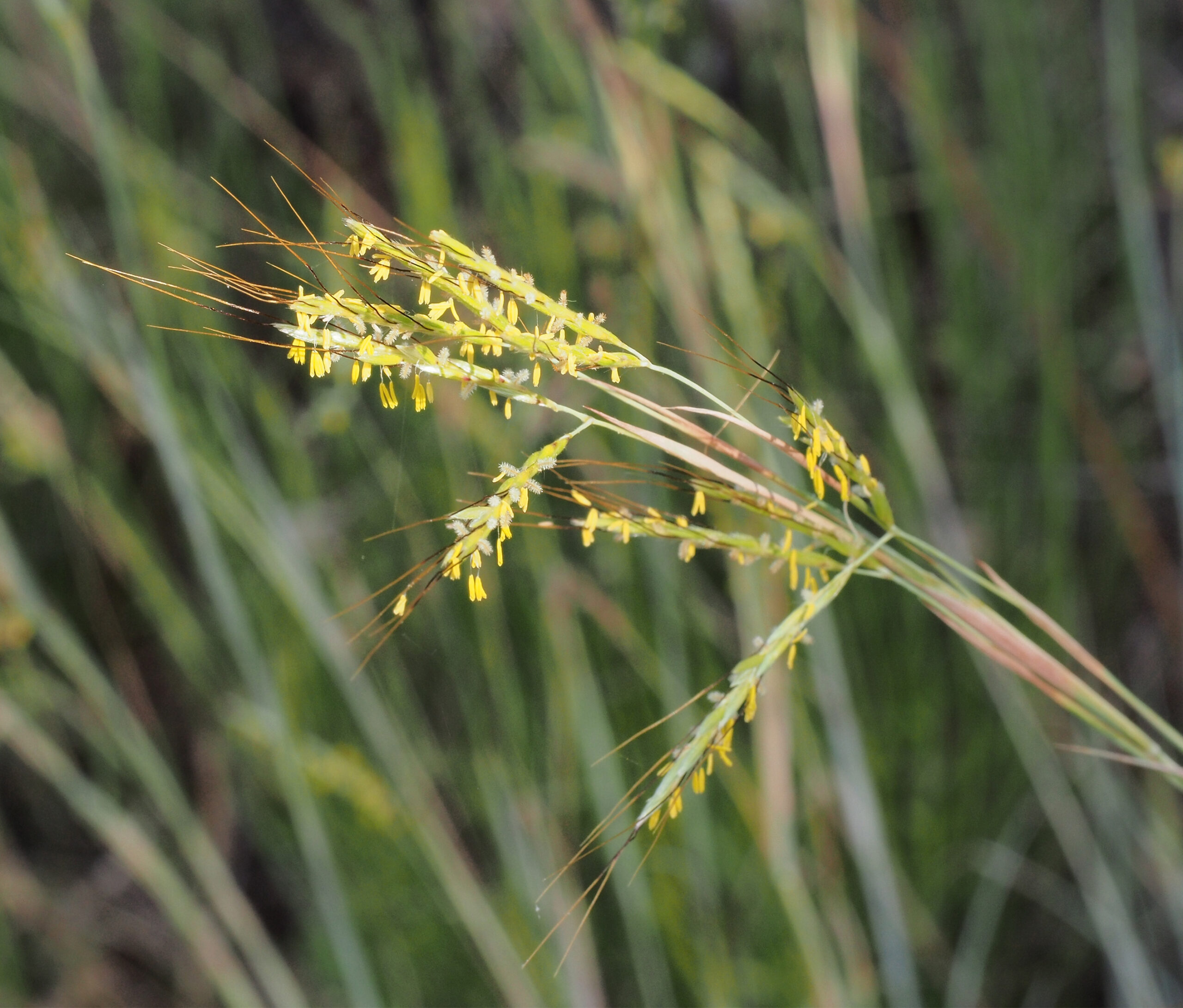
Common thatching grass (Hyparrhenia hirta). Photo by Luis Fernández García (Wikimedia Commons, Creative Commons Attribution-Share Alike 4.0 International license).
Giant rat’s tail grass (Sporobolus pyramidalis)
The giant rat’s tail grass is a perennial C4 plant commonly found in the eastern lowland region of the veldt. The plant can produce up to 85,000 seeds per square meter (about 11 square feet) in a year and is invasive in other parts of the world, including Australia. It is a dense, tufted grass that grows up to 2 meters (about 6.6 feet) tall. It has a paniculate inflorescence and flowers from March to May, with fruiting occurring from May to June.
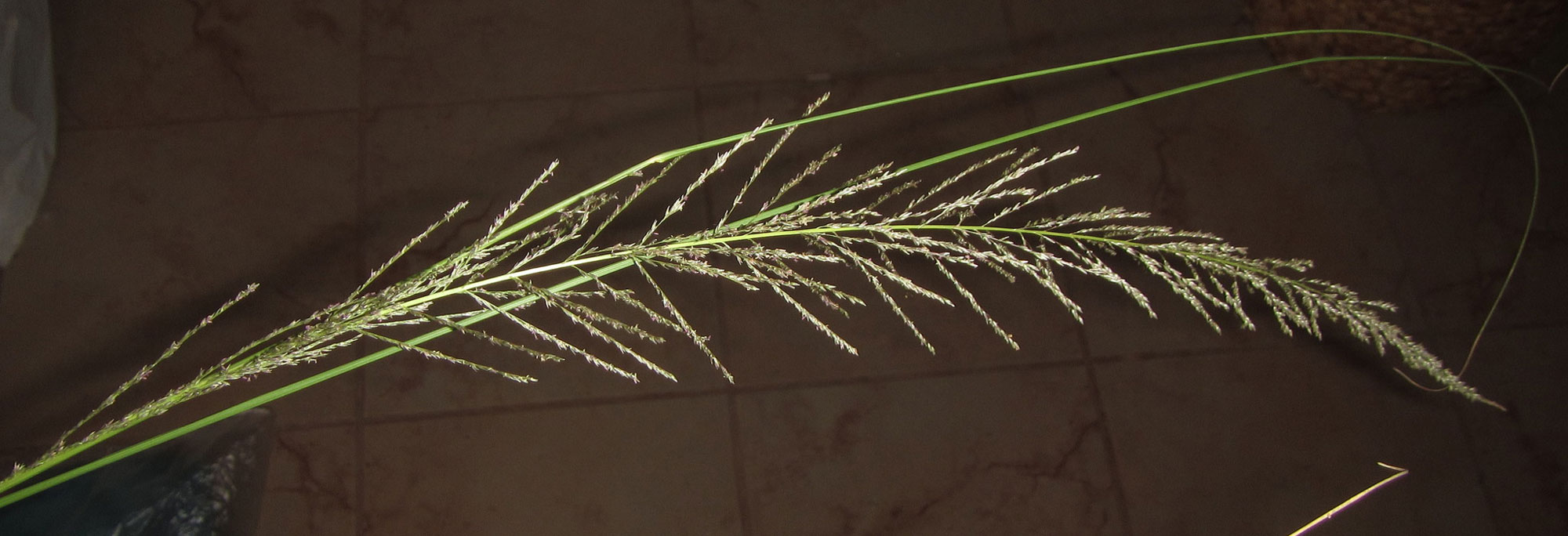
Giant rat’s tail grass (Sporobolus pyramidalis). Photo by Ricky Taylor (iNaturalist photo 63111047, Creative Commons Attribution-NonCommercial 4.0 International license).
Australian temperate savannas
Overview of Australian temperate savannas
The Australian temperate savanna region spans the Australian states of New South Wales, Victoria, and a small portion of southern Queensland. The grasslands are surrounded by deserts to the west and temperate rainforests to the east. There are several non-continuous areas of grassland with different dominant species.
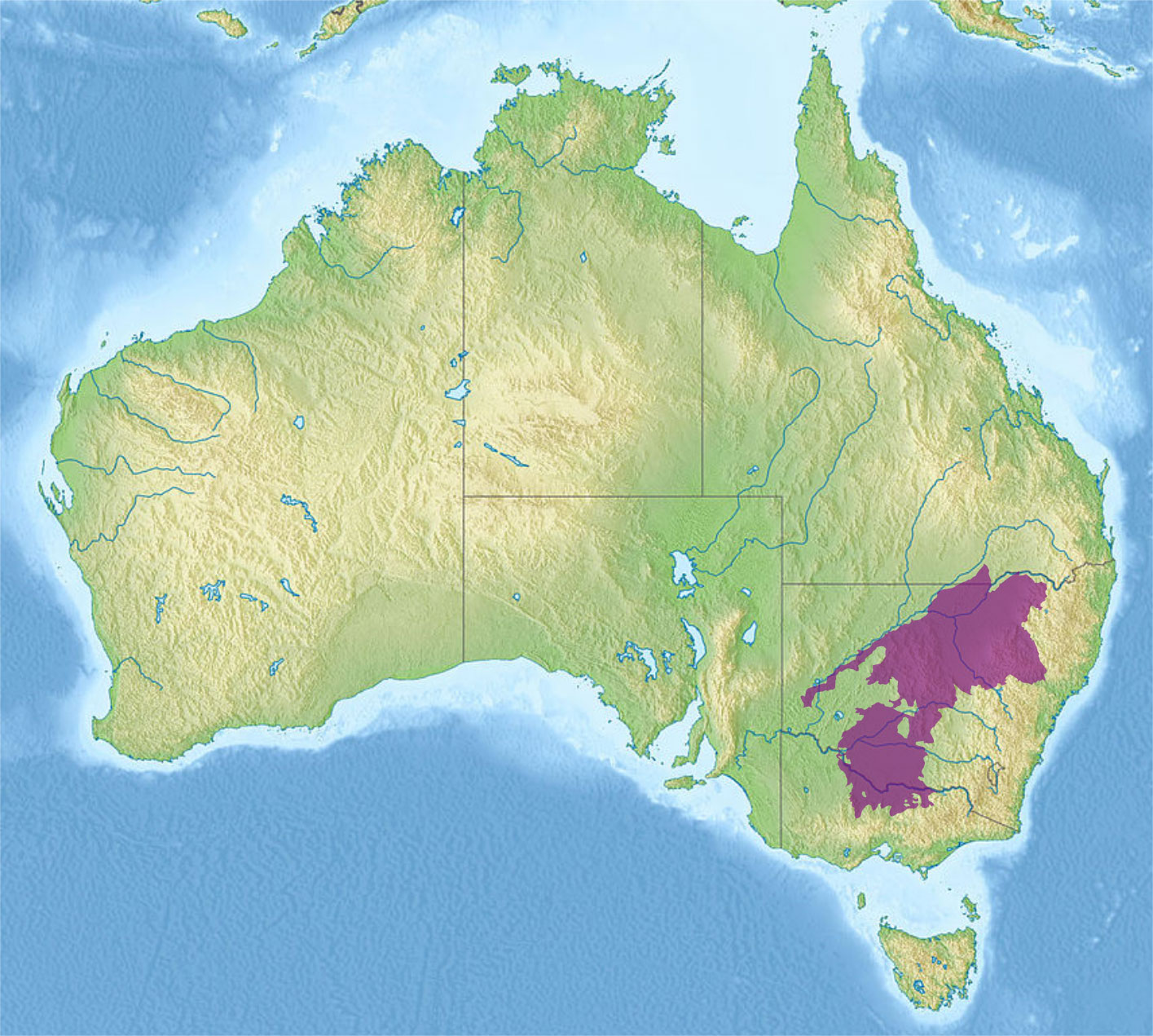
Distribution of Australian temperate savannas. Map by Every-leaf-that-trembles (Wikimedia Commons, Creative Commons Attribution 4.0 International license).
Non-grass plants in the temperate grasslands include several species of eucalyptus trees, such as the red river gum (Eucalyptus camaldulensis) and black box (Eucalyptus largiflorens). Animals include marsupials, such as the kultarr (Antechinomys laniger) and the brush-tailed rock wallaby (Petrogale penicillata). The savannas are also home to various birds, including the superb parrot (Polytelis swainsonii), the red goshawk (Erythrotriorchis radiatus), and the malleefowl (Leipoa ocellata).
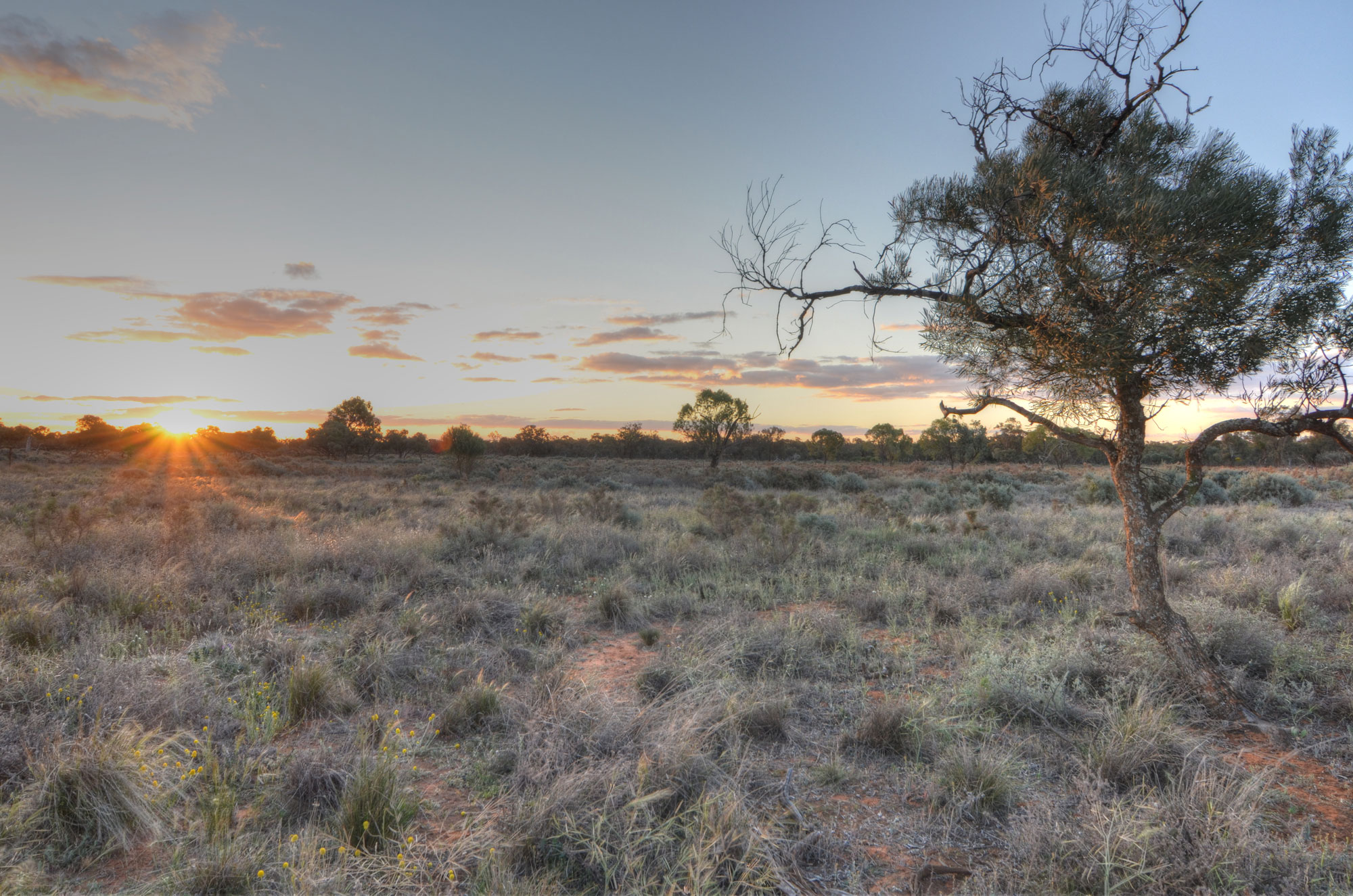
Australian savanna, Lake Mungo, New South Wales, Australia. Photo by Davidspicerj (Wikimedia Commons, Creative Commons Attribution-ShareAlike 4.0 International license).
Temperate savanna species spotlights
Purplish wallaby grass (Rytidosperma tenuius)
Purplish wallaby grass is a perennial C3 grass. It is best suited to grow on clay or sandy soils and may reach 1.2 m (nearly 4 feet) tall. It flowers in the spring and produces red to purple inflorescences, for which it is named.
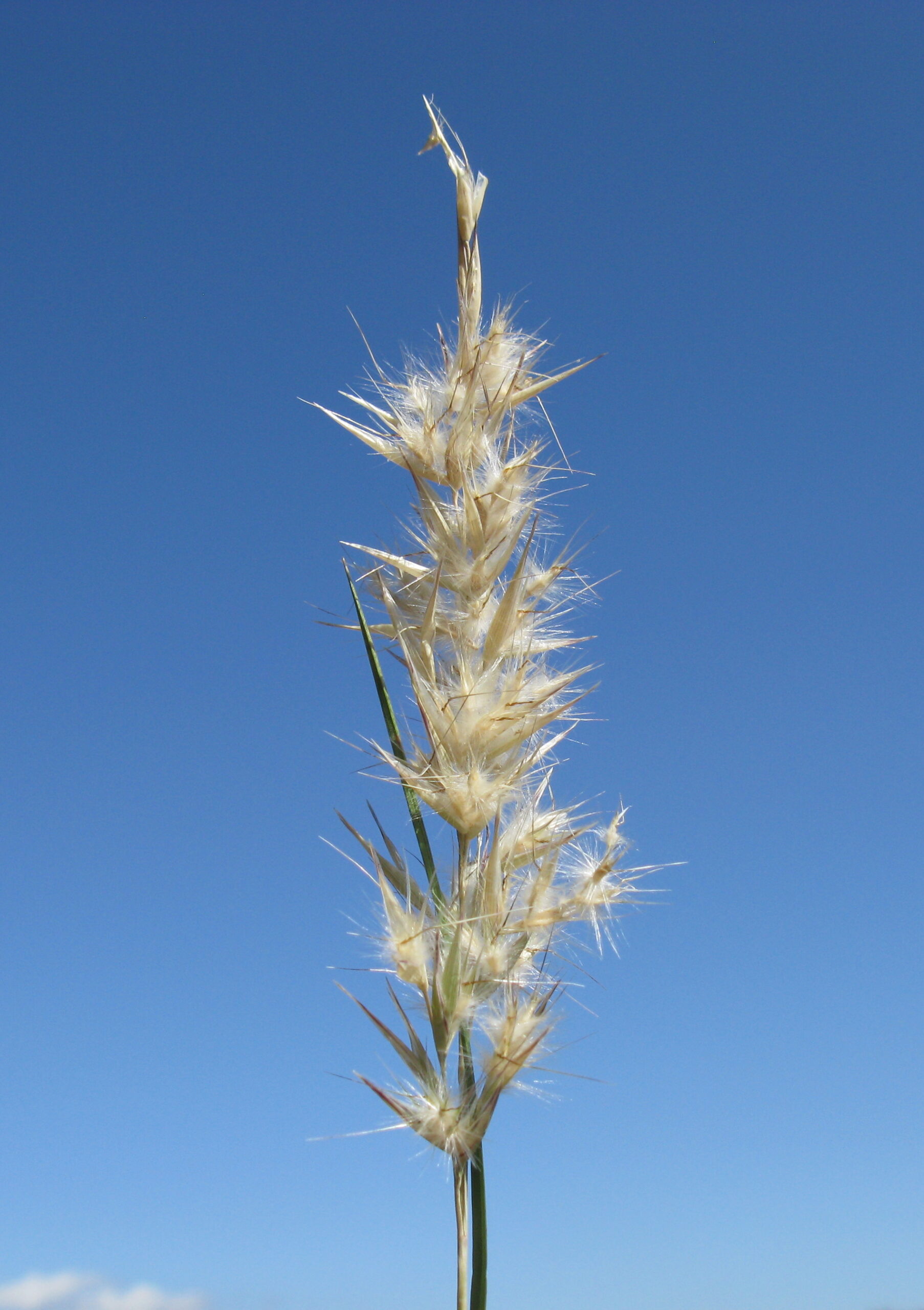
Purplish wallaby-grass (Rytidosperma tenuius). Photo by Harry Rose (flickr, Creative Commons Attribution 2.0 Generic license).
Bristly wallaby grass (Rytidosperma setaceum)
Bristly wallaby grass is a perennial C3 grass. It grows in a clumping form, and may be up to 60 centimeters (nearly 2 feet) tall. It flowers from October to January.
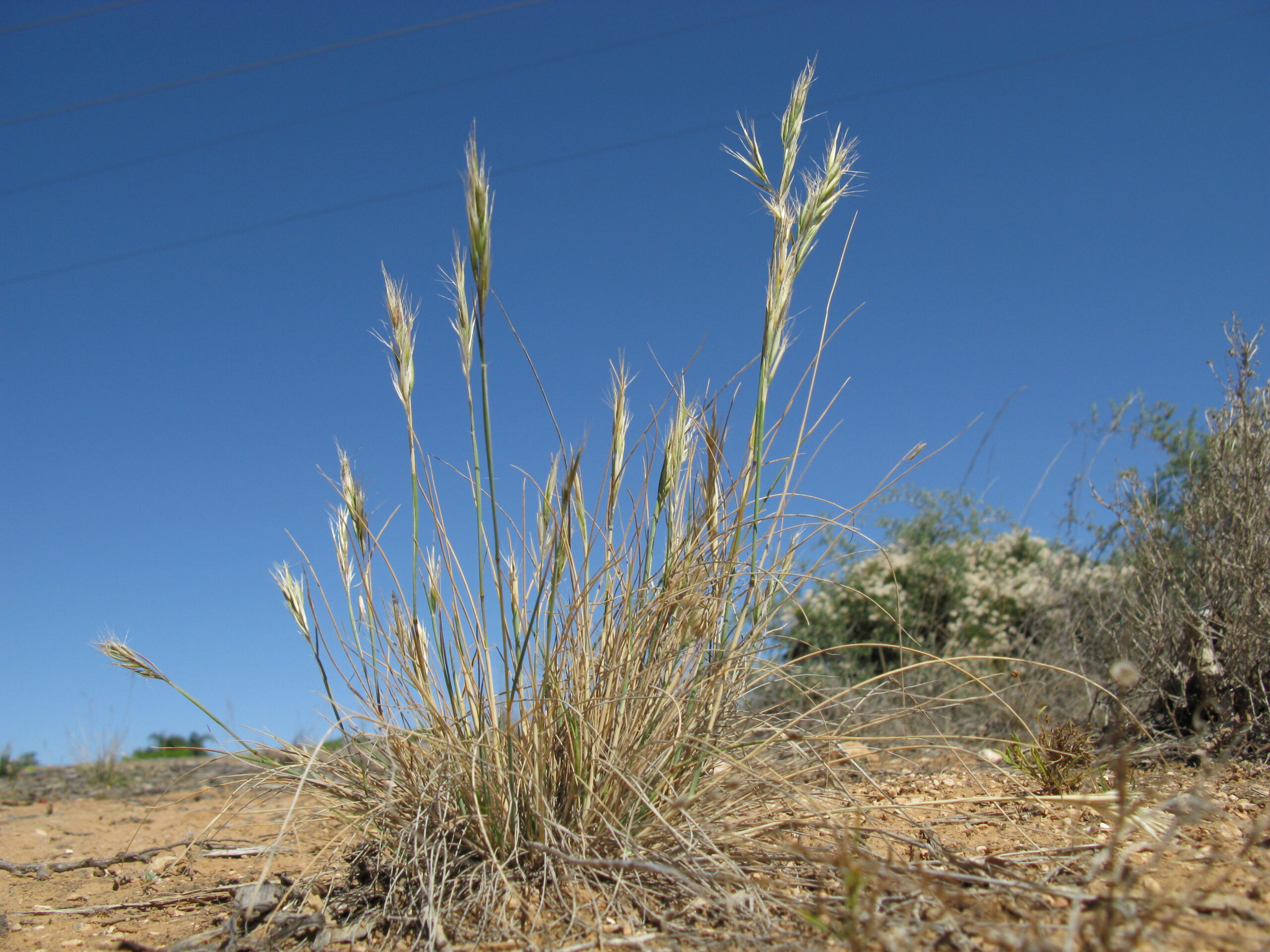
Bristly wallaby-grass (Rytidosperma setaceum). Photo by Harry Rose (flickr, Creative Commons Attribution 2.0 Generic license).
Other species
Some other species found in Australian temperate grasslands also occur in Australian tropical grasslands. These include grasses such as speargrass (Austrostipa scabra), curly windmill grass (Enteropogon acicularis), windmill grass (Chloris truncata), and red leg grass (Bothriochloa macra).
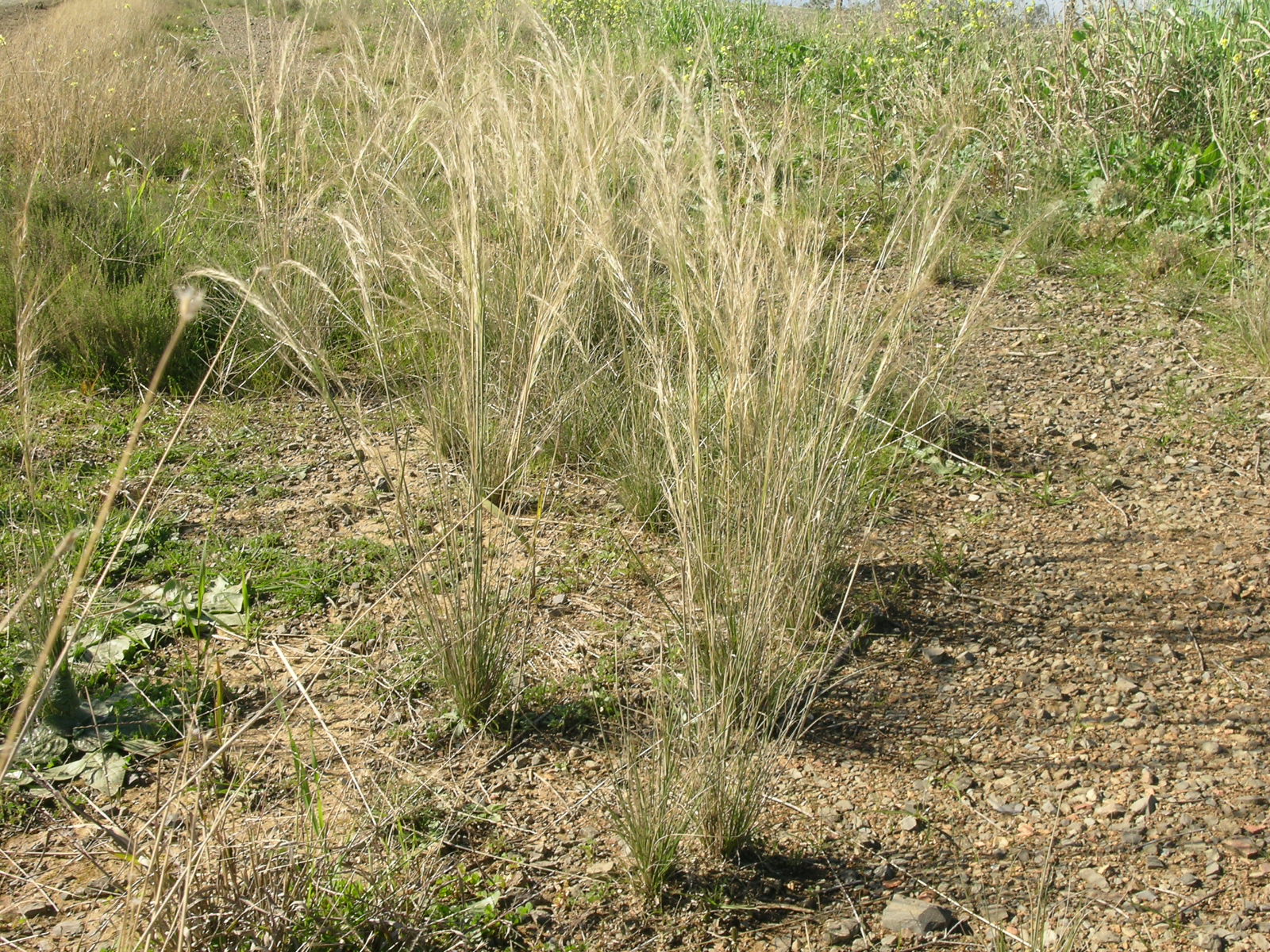
Speargrass (Austrostipa scabra). Photo by Harry Rose (flickr, Creative Commons Attribution 2.0 Generic license).
New Zealand tussocks
Overview of tussocks
Grasslands in New Zealand are referred to as tussock grasslands, named after the tussock grasses which dominate the landscape. Tussock grasses have a clumping growth form, which provides fire resistance. There are 190 grass species, including 30 species of native tussock, in New Zealand. There are three genera of native tussocks: Chionochloa, Poa, and Festuca.
Tussock grasslands are found across the South Island and in the central plateau of the North Island. They occur in semi-arid climates, ranging from regions with subtropical climates in the north to regions with temperate climates in the south. Temperatures dip below freezing in the temperate tussock grasslands, and rainfall can be as low as 35 centimeters (about 14 inches) per year.
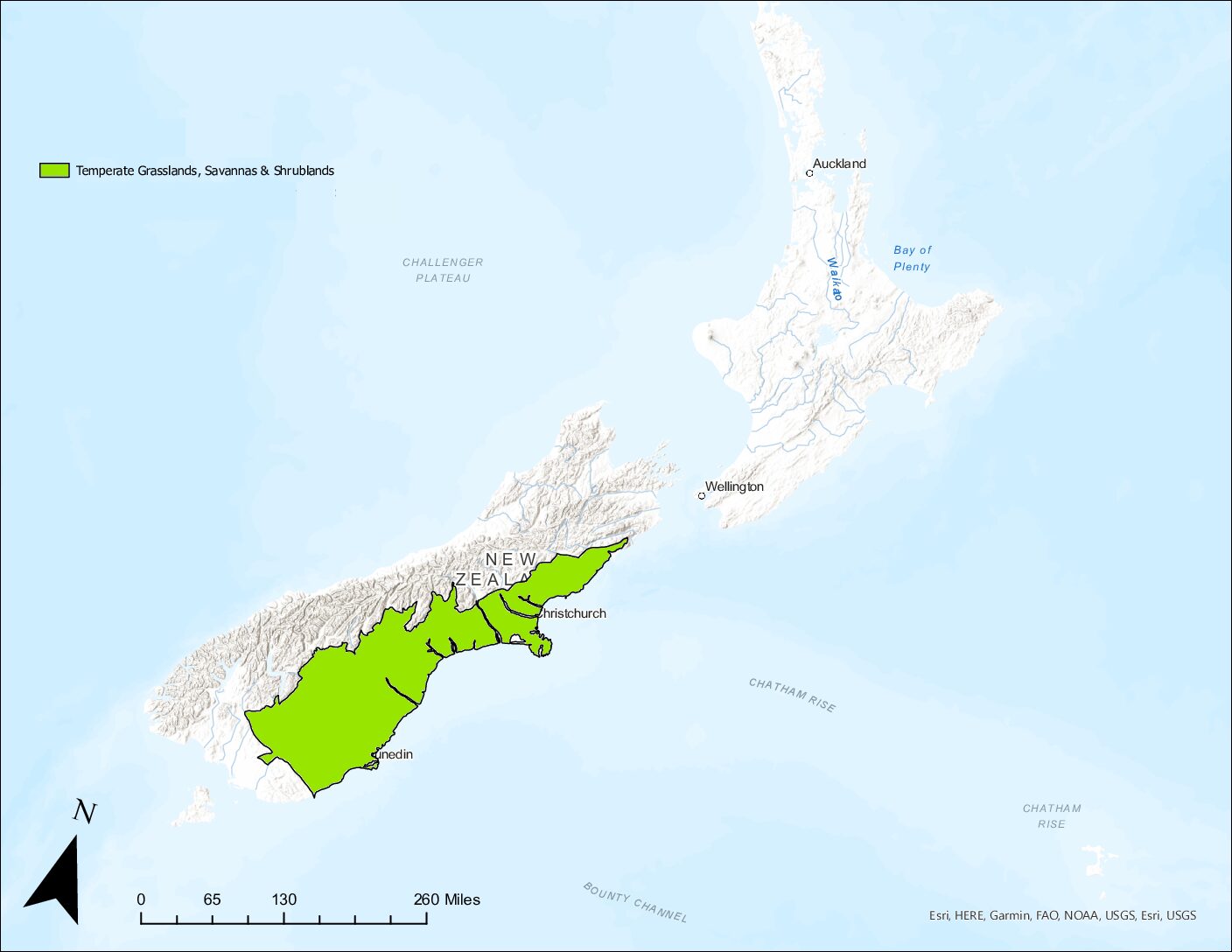
Map of Tussock grasslands in New Zealand, created by N. Schulberg.
The tussocks are split into regions based on the heights of the grasses. The two regions are short tussocks and tall tussocks. Short tussock grasses are generally less than 50 centimeters (about 20 inches) tall. They grow at lower altitudes, and common species include silver tussock (Poa cita), hard tussock (Festuca novae-zelandiae), and blue wheatgrass (Elymus solandri).
Tall tussocks grasses are generally taller than 50 centimeters (about 20 inches). Tall tussocks are dominated by the genus Chionochloa, which is endemic to New Zealand. They are often found in areas that are peaty and acidic. Common species include red tussock (Chionochloa rubra), and the subspecies copper tussock (subsp. cuprea). Tall tussock grasslands are found in alpine regions 500 meters (about 1640 feet) above the treeline. These higher altitude regions are called “snow tussocks” and are dominated by narrowed-leafed snow tussock (Māori wī kura, Chionochloa rigida).
The tussocks are also home to many endemic animal species, including the great spotted kiwi (Apteryx haastii), and the grasshopper alpine weta (Deinaacrida pluvialis).
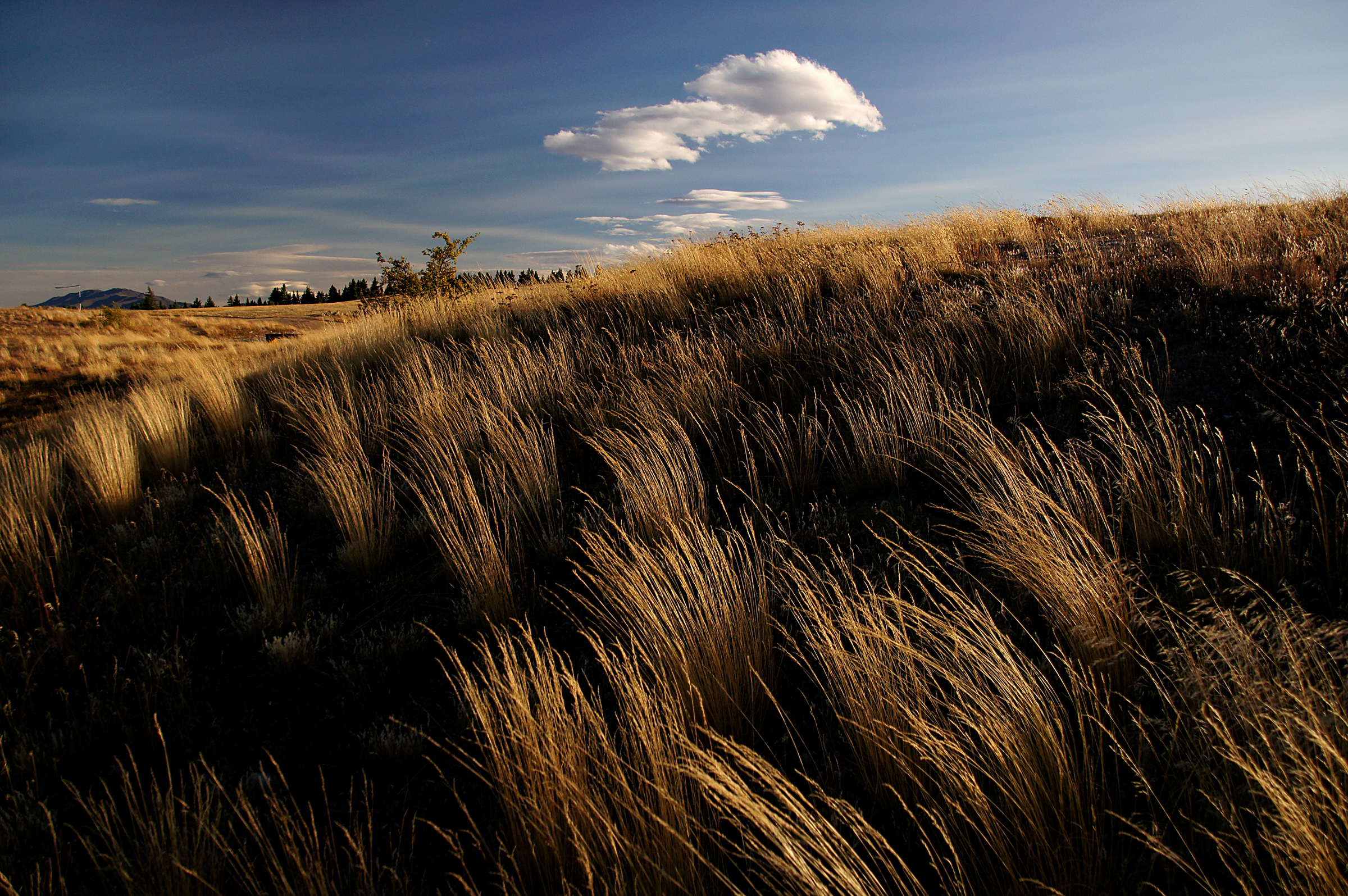
Tussock grasses, South Island, New Zealand. Photo by Bernard Spragg (Wikimedia Commons, Creative Commons CC0 1.0 Universal Public Domain Dedication).
Tussock species spotlights
Silver tussock or wī (Poa cita)
Silver tussock (Māori name: wī) is a perennial C3 species that is endemic to New Zealand. It is a very drought-tolerant species found in the short tussocks and grows to heights of 2.5 feet (about 76 centimeters). It flowers in the summer and produces brown inflorescences.

Silver tussock (Poa cita), North Island, New Zealnd. Photo by rempson (Wikimedia Commons, Creative Commons Attribution 4.0 International license).
Hard tussock (Festuca novae-zelandiae)
Hard tussock is a perennial C3 species that is endemic to New Zealand. It grows to heights of 70 cm (about 27 to 28 inches) and is found in the short tussock in association with silver tussock grass. It is commonly found on dry, well-drained soil and has a paniculate inflorescence.
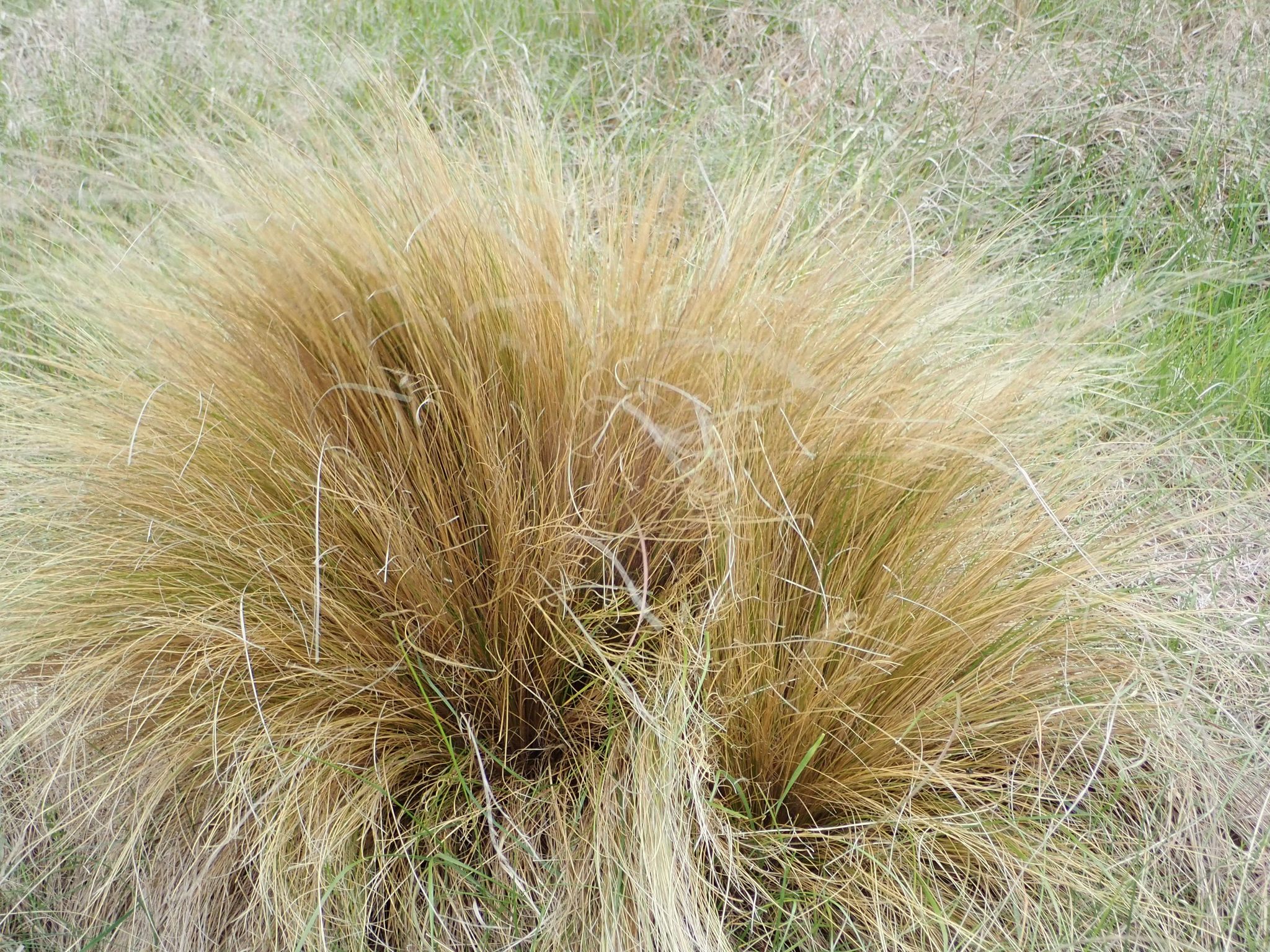
Hard tussock (Festuca novae-zelandiae), South Island, New Zealand. Photo by John Steel (Wikimedia Commons, Creative Commons Attribution 4.0 International license).
Blue wheatgrass (Anthosachne solandri)
Blue wheatgrass is a perennial C3 species that is endemic to New Zealand. It has blue-grey leaves that are up to 20 centimeters (about 8 inches) long and flower spikes that are up to 40 centimeters (about 16 inches) tall. It is found at elevations up to 1500 meters (about 4900 feet) in the short tussock. It is a clumping grass that blooms in the summer.

Blue wheatgrass (Anthosachne solandri), cultivated, Auckland Botanic Gardens, New Zealand. Photo from Krzysztof Ziarnek (Wikimedia Commons, Creative Commons Attribution 4.0 International license).
Red tussock (Chionochloa rubra)
Red tussock is a perennial C3 grass that is endemic to New Zealand. Its name comes from the distinctive red color of its leaves. It grows to be 1.2 m tall, and is able to withstand a variety of environmental conditions. Unlike most other species, it has been documented to produce many seeds in response to seeding predation.

Red tussock (Chionochloa rubra). Photo from Krzysztof Golik (Wikimedia Commons, Creative Commons Attribution 4.0 International license).
Narrow-leaved snow tussock (wī kura) (Chionochloa rigida)
Narrow-leaved snow tussock is a perennial C3 grass that is endemic to New Zealand, found only in the South Island. It grows to be around 1 meter (3.2 feet) and is a common species in the tall tussocks. It is found in drier soils and alpine zones and is hardy in cold temperatures. It flowers in the summer.
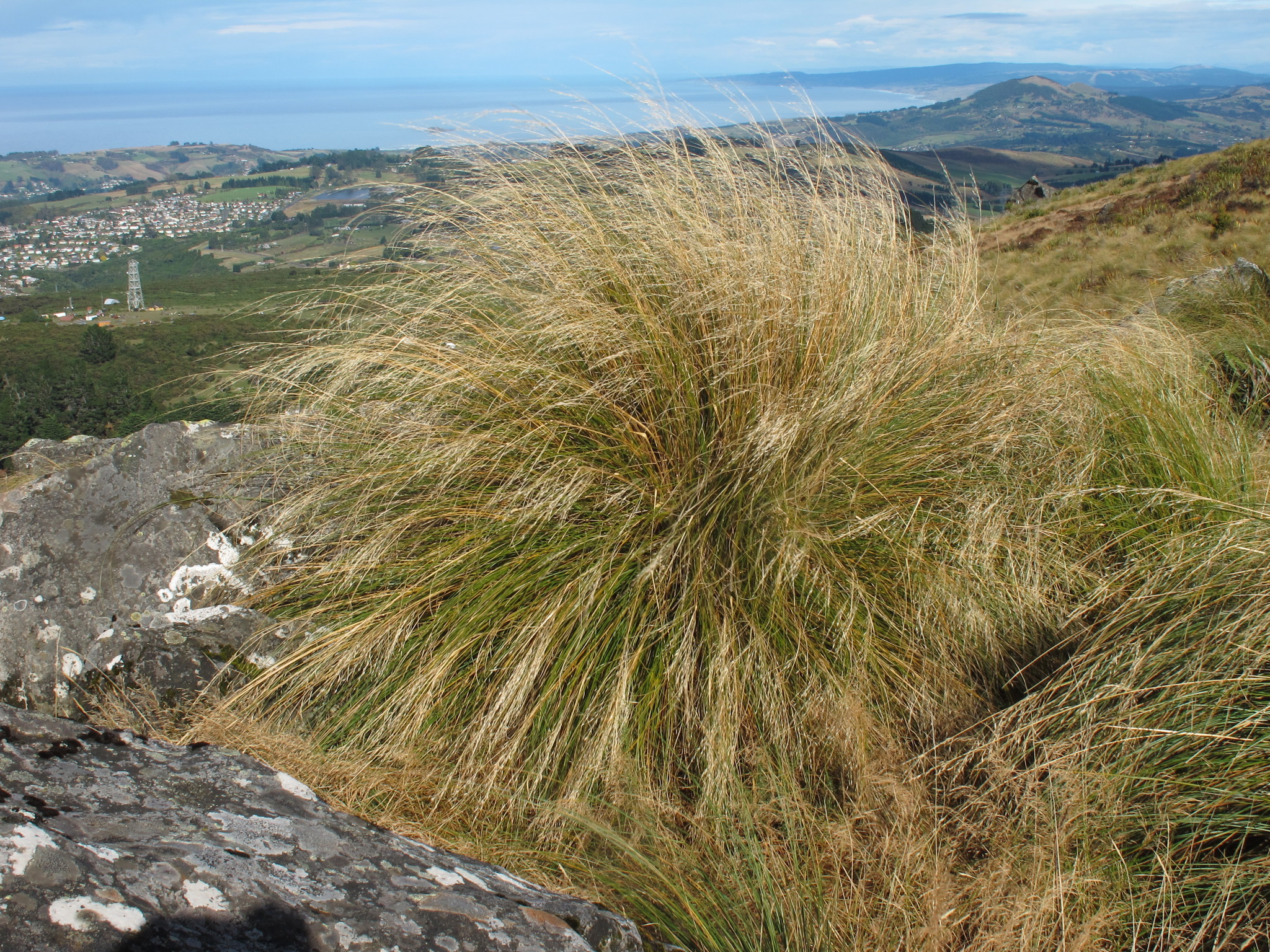
Narrow-leaved snow tussock (Chionochloa rigida), South Island, New Zealand. Photo by John Barkla (Wikimedia Commons, Creative Commons Attribution 4.0 International license).
Resources
Websites
Andean Mountain Grasslands Bioregion (One Earth): https://www.oneearth.org/bioregions/andean-mountain-grasslands-nt5/
East Australian Mediterranean Woodlands & Temperate Savannas Bioregion (One Earth): https://www.oneearth.org/bioregions/east-australian-mediterranean-woodlands-temperate-savannas-au4/
Pampas biome (Blue Planet Biomes): https://www.blueplanetbiomes.org/pampas.php
Prairies and grasslands (Wind Cave National Park, U.S. National Park Service): https://www.nps.gov/wica/learn/nature/prairies.htm
Rio De La Plata Grasslands Bioregion (One Earth): https://www.oneearth.org/bioregions/rio-de-la-plata-grasslands-nt3/
Articles, reports, & book chapters
Scientific articles
Sala, O.E. 2001. Temperate Grasslands. In: Chapin, F.S., Sala, O.E., Huber-Sannwald, E. (eds.), Global Biodiversity in a Changing Environment. Ecological Studies, 152. Springer, New York, New York. https://doi.org/10.1007/978-1-4613-0157-8_7



